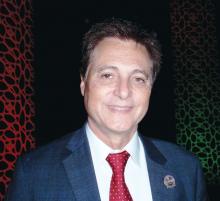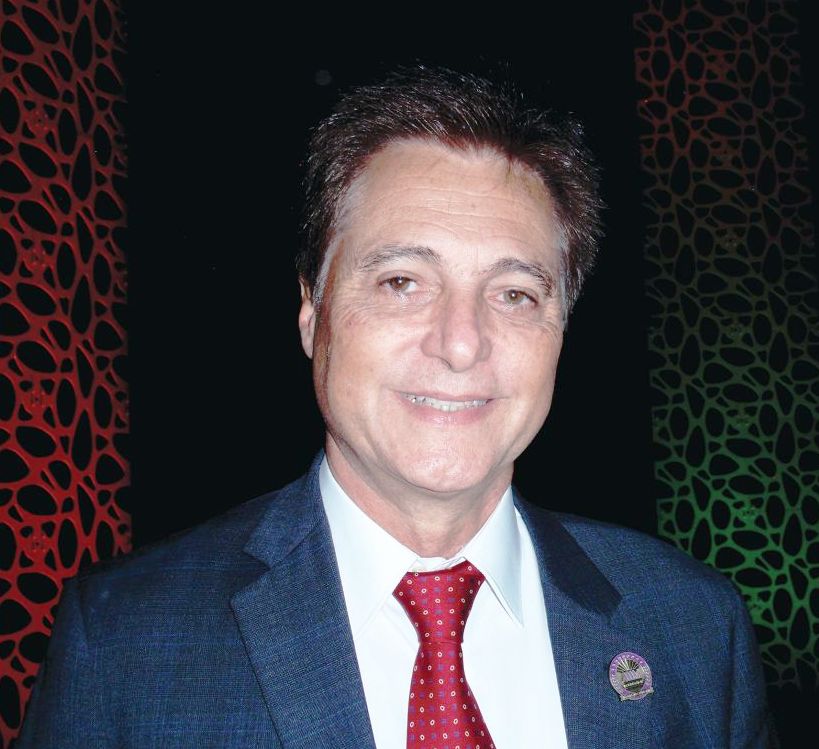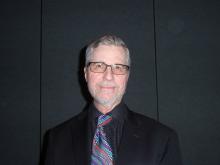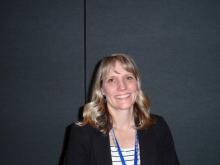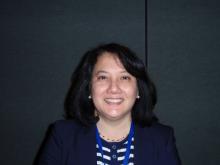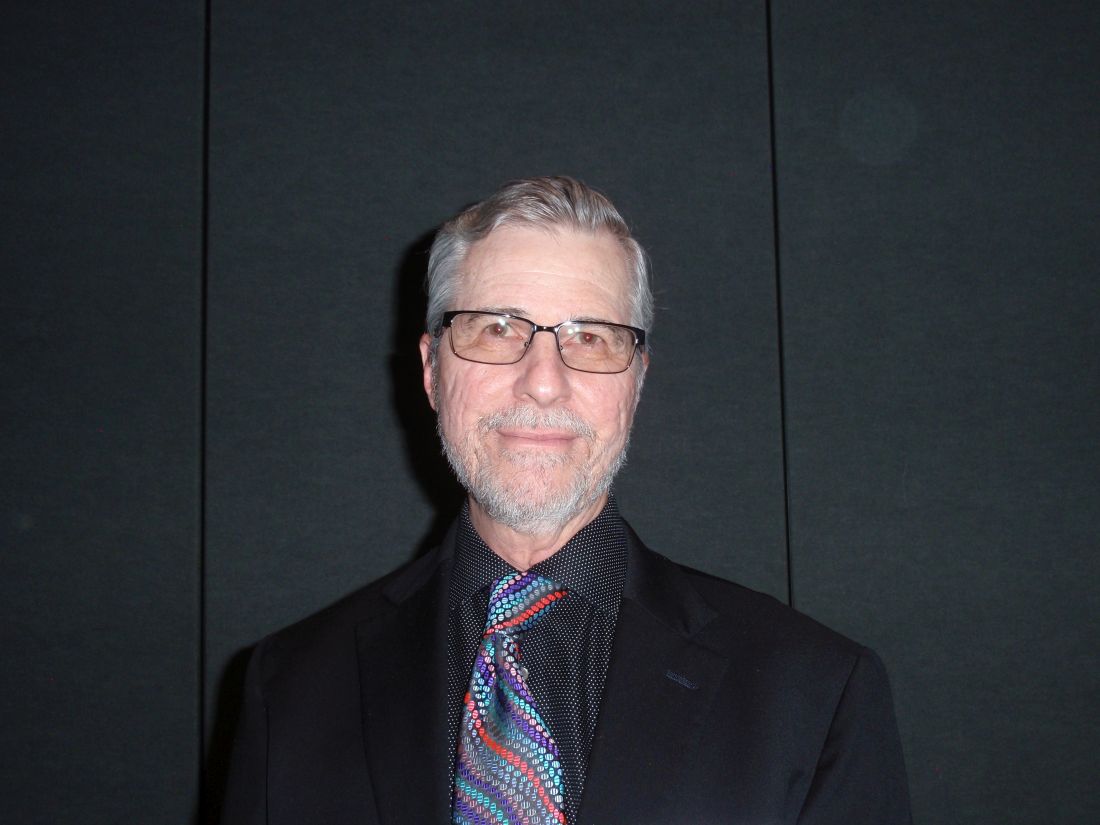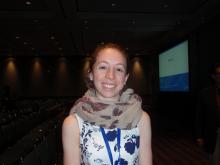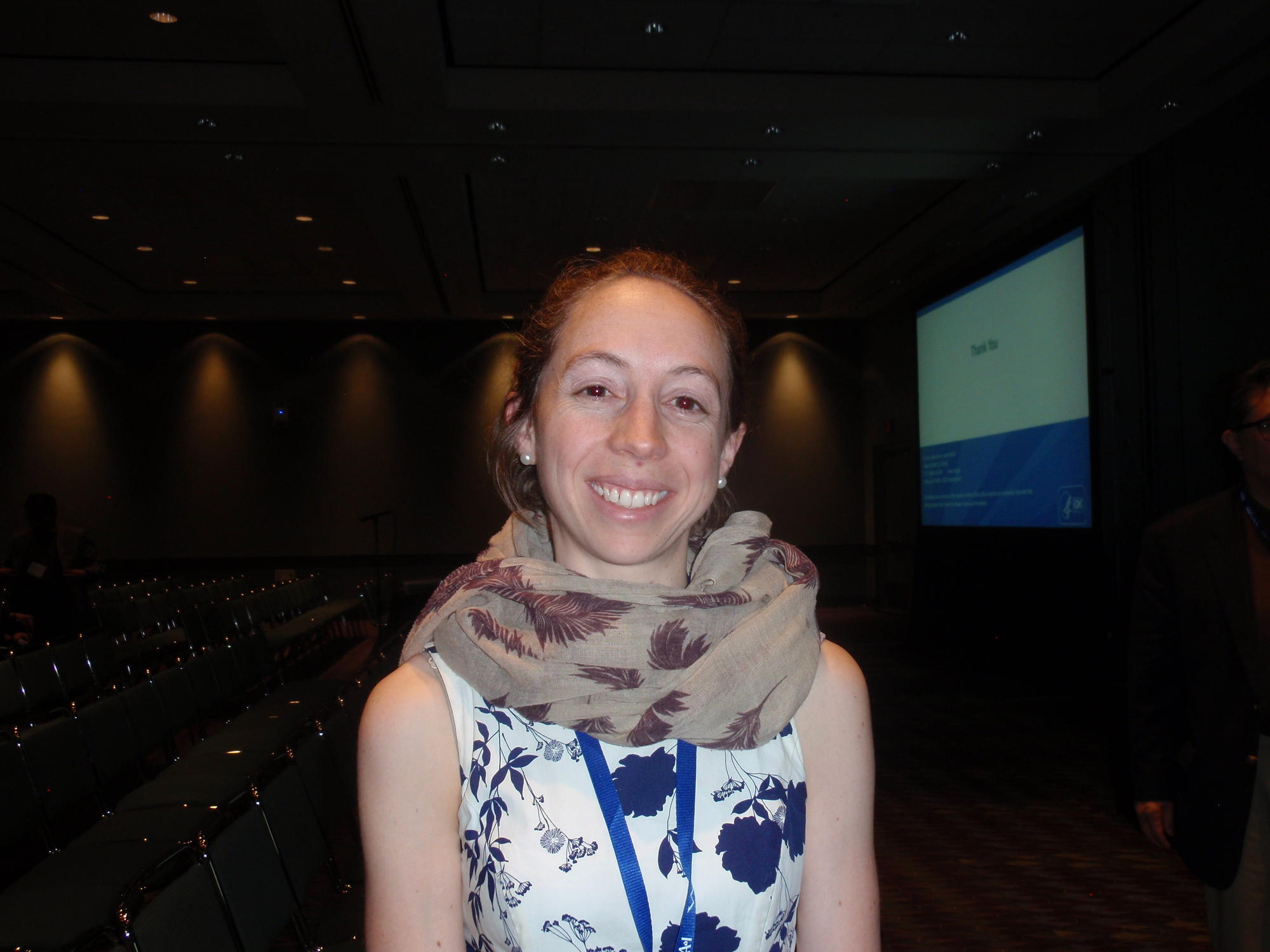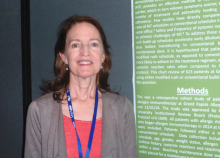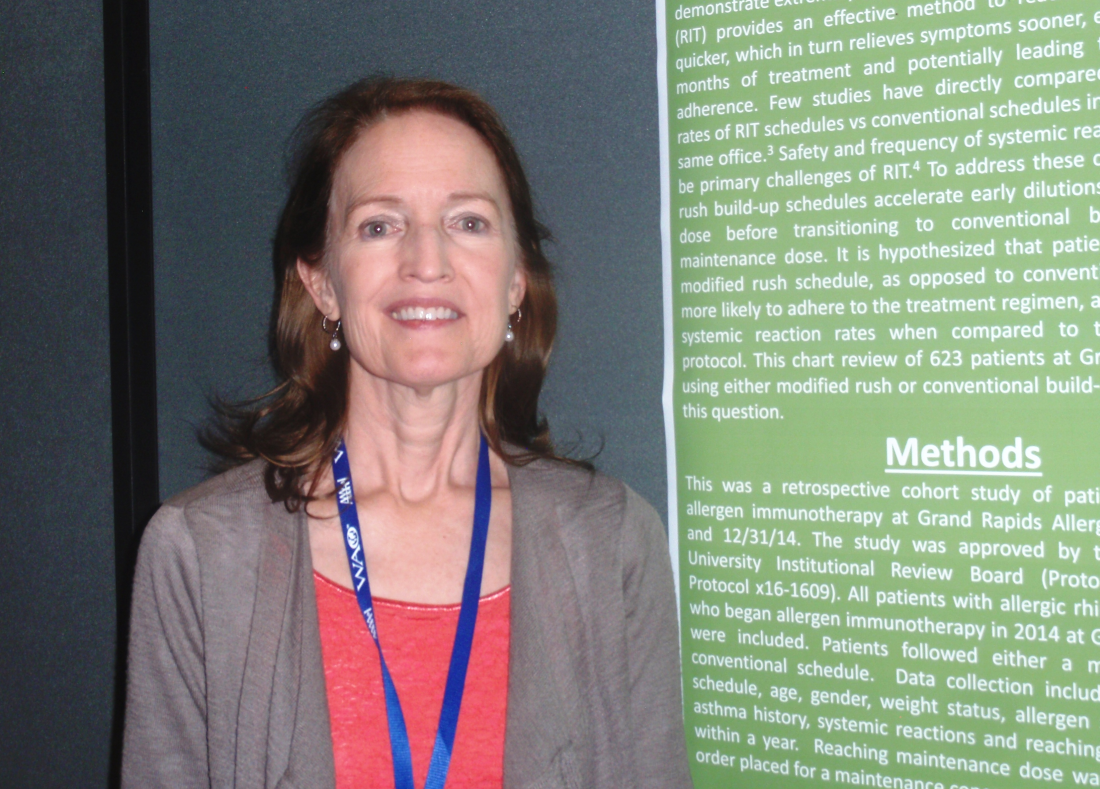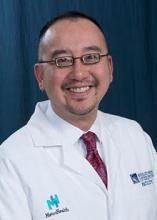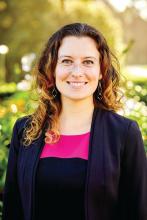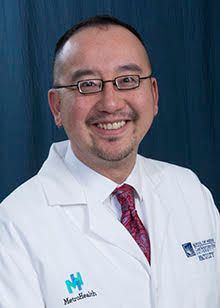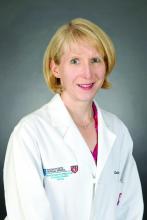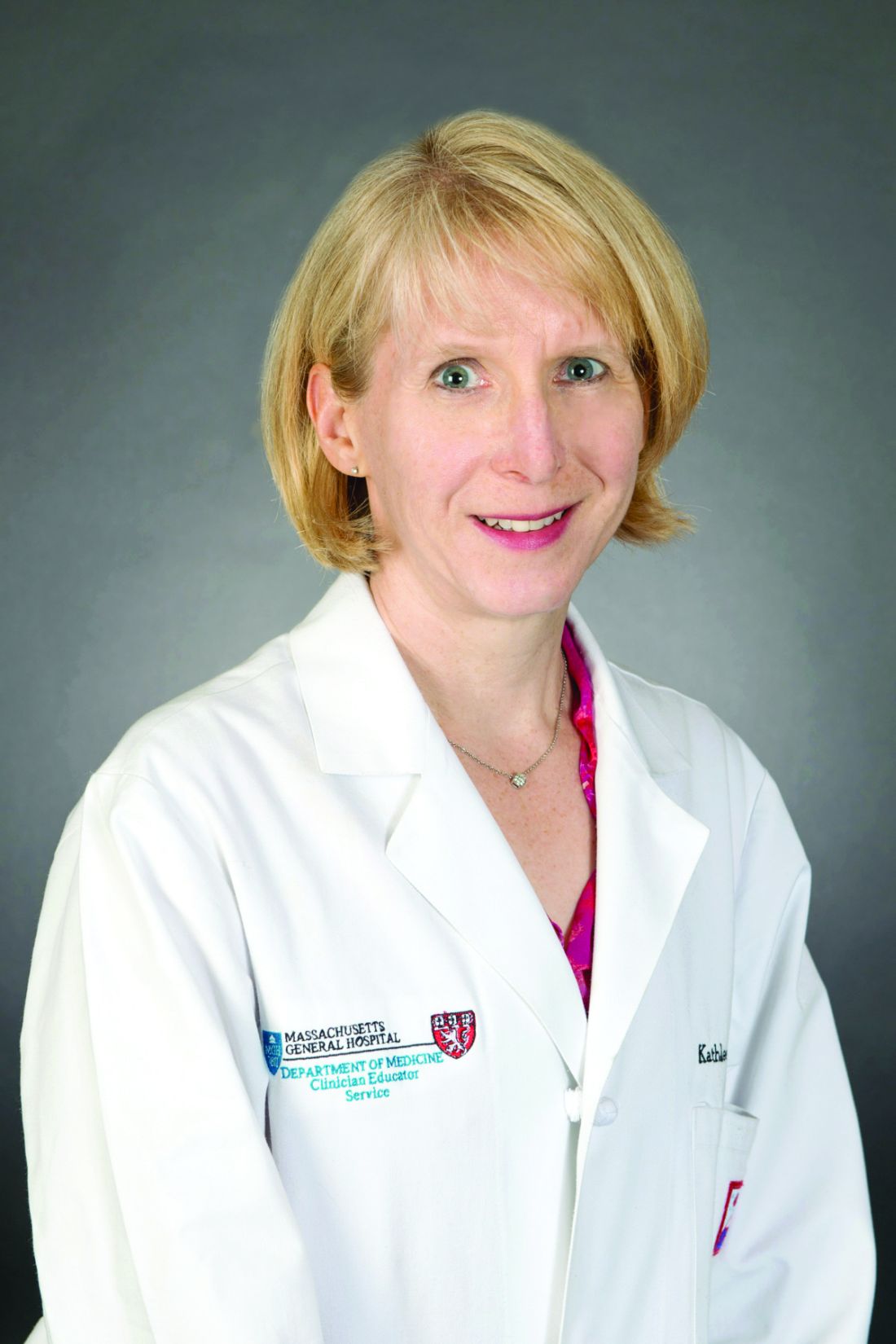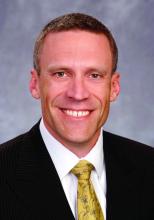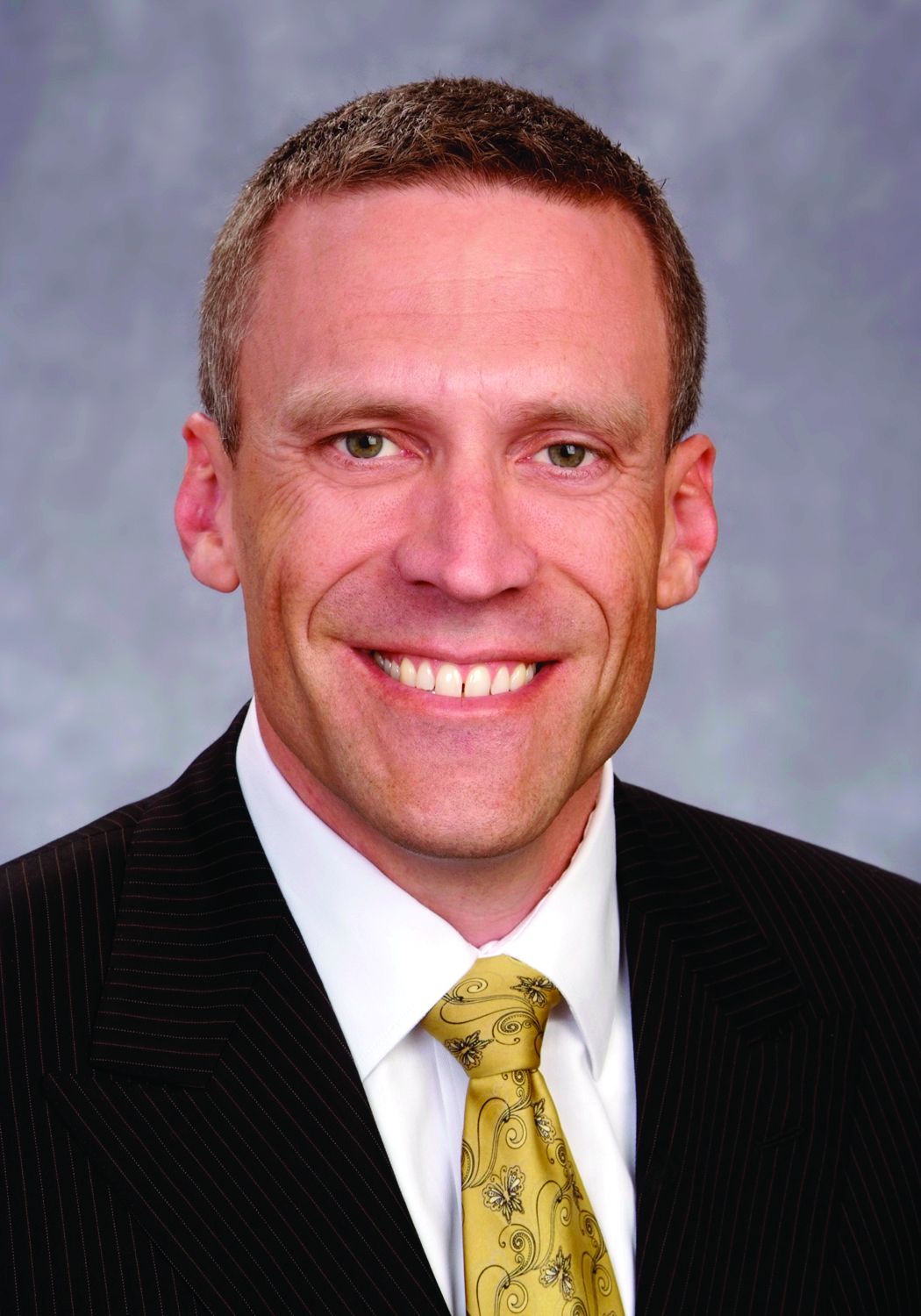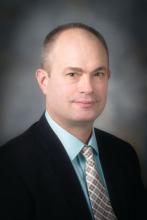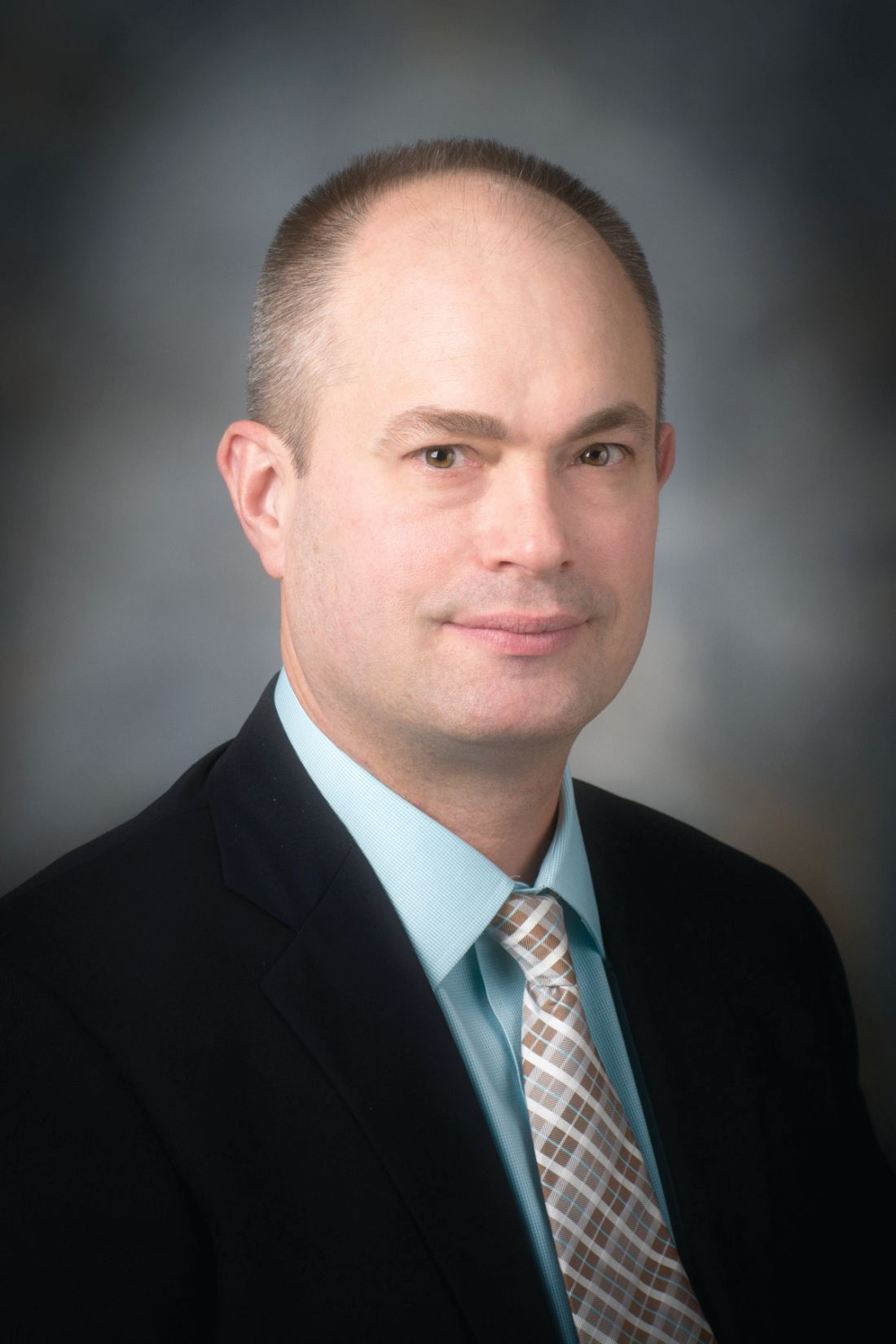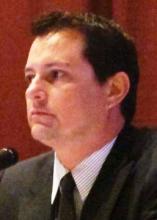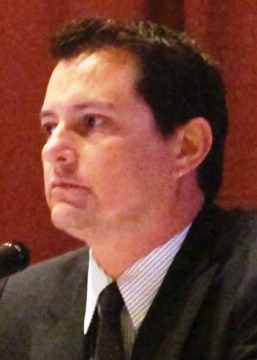User login
Tom Collins is a freelance writer in South Florida who has written about medical topics from nasty infections to ethical dilemmas, runaway tumors to tornado-chasing doctors. He travels the globe gathering conference health news and lives in West Palm Beach.
Climate change is worsening allergies, expert says
ORLANDO – Climate change is not just eroding coastlines and threatening seaside cities and taking lives with increasingly powerful hurricanes, but appears to be contributing to increases in allergy and asthma, an expert told the audience at the joint congress of the American Academy of Allergy, Asthma and Immunology and the World Asthma Organization.
Longer pollen seasons, allergens unleashed by felled trees and ripped-up plants, mold growth following floods, and irritants launched into the air by wildfires are some of the concerns that should be alarming physicians and policy makers, said Nelson A. Rosario, MD, PhD, professor of pediatrics at Federal University of Paraná (Brazil).
And evidence suggests that his fellow allergists and their patients agree.
A 2015 international survey found that 80% of rhinitis patients blamed climate change for contributing to their symptoms.
Only 11% said that climate change wasn’t relevant at all. Asked how patients have been affected by climate change, about two-thirds said “increased care for allergic sensitization and symptoms on exposure to plants or mold.”
Science supports these views, Dr. Rosario said.
A 2011 study of North American pollen seasons found that some cities had significant increases of 11-27 days, compared with 15 years before.
And a 2017 review noted the impacts of the consequences of climate change, from increased allergies due to heavy precipitation events, asthma prompted by intense tropical cyclones, and allergic conditions caused by extremely high sea levels.
Dr. Rosario suggested that, rather than wait for official agencies to take action, physicians need to adapt and help their patients adapt. A team of doctors wrote in 2013 that while “improved governmental controls” could lead to cleaner air, they “meet strong opposition because of their effect on business and productivity.” So, they said, the allergy community should adjust, by “anticipating the needs of patients and by adopting practices and research methods to meet changing environmental conditions.”
Dr. Rosario urged physicians to think of the climate-change effects on allergy and asthma as a “collective action” problem, not an individual one.
“The consequences will come,” he said. “There must be international cooperation.”
ORLANDO – Climate change is not just eroding coastlines and threatening seaside cities and taking lives with increasingly powerful hurricanes, but appears to be contributing to increases in allergy and asthma, an expert told the audience at the joint congress of the American Academy of Allergy, Asthma and Immunology and the World Asthma Organization.
Longer pollen seasons, allergens unleashed by felled trees and ripped-up plants, mold growth following floods, and irritants launched into the air by wildfires are some of the concerns that should be alarming physicians and policy makers, said Nelson A. Rosario, MD, PhD, professor of pediatrics at Federal University of Paraná (Brazil).
And evidence suggests that his fellow allergists and their patients agree.
A 2015 international survey found that 80% of rhinitis patients blamed climate change for contributing to their symptoms.
Only 11% said that climate change wasn’t relevant at all. Asked how patients have been affected by climate change, about two-thirds said “increased care for allergic sensitization and symptoms on exposure to plants or mold.”
Science supports these views, Dr. Rosario said.
A 2011 study of North American pollen seasons found that some cities had significant increases of 11-27 days, compared with 15 years before.
And a 2017 review noted the impacts of the consequences of climate change, from increased allergies due to heavy precipitation events, asthma prompted by intense tropical cyclones, and allergic conditions caused by extremely high sea levels.
Dr. Rosario suggested that, rather than wait for official agencies to take action, physicians need to adapt and help their patients adapt. A team of doctors wrote in 2013 that while “improved governmental controls” could lead to cleaner air, they “meet strong opposition because of their effect on business and productivity.” So, they said, the allergy community should adjust, by “anticipating the needs of patients and by adopting practices and research methods to meet changing environmental conditions.”
Dr. Rosario urged physicians to think of the climate-change effects on allergy and asthma as a “collective action” problem, not an individual one.
“The consequences will come,” he said. “There must be international cooperation.”
ORLANDO – Climate change is not just eroding coastlines and threatening seaside cities and taking lives with increasingly powerful hurricanes, but appears to be contributing to increases in allergy and asthma, an expert told the audience at the joint congress of the American Academy of Allergy, Asthma and Immunology and the World Asthma Organization.
Longer pollen seasons, allergens unleashed by felled trees and ripped-up plants, mold growth following floods, and irritants launched into the air by wildfires are some of the concerns that should be alarming physicians and policy makers, said Nelson A. Rosario, MD, PhD, professor of pediatrics at Federal University of Paraná (Brazil).
And evidence suggests that his fellow allergists and their patients agree.
A 2015 international survey found that 80% of rhinitis patients blamed climate change for contributing to their symptoms.
Only 11% said that climate change wasn’t relevant at all. Asked how patients have been affected by climate change, about two-thirds said “increased care for allergic sensitization and symptoms on exposure to plants or mold.”
Science supports these views, Dr. Rosario said.
A 2011 study of North American pollen seasons found that some cities had significant increases of 11-27 days, compared with 15 years before.
And a 2017 review noted the impacts of the consequences of climate change, from increased allergies due to heavy precipitation events, asthma prompted by intense tropical cyclones, and allergic conditions caused by extremely high sea levels.
Dr. Rosario suggested that, rather than wait for official agencies to take action, physicians need to adapt and help their patients adapt. A team of doctors wrote in 2013 that while “improved governmental controls” could lead to cleaner air, they “meet strong opposition because of their effect on business and productivity.” So, they said, the allergy community should adjust, by “anticipating the needs of patients and by adopting practices and research methods to meet changing environmental conditions.”
Dr. Rosario urged physicians to think of the climate-change effects on allergy and asthma as a “collective action” problem, not an individual one.
“The consequences will come,” he said. “There must be international cooperation.”
EXPERT ANALYSIS FROM AAAAI/WAO JOINT CONGRESS
Data paint mixed picture on e-cigarettes
ORLANDO – E-cigarettes are likely safer than traditional cigarettes but it depends on the user, the voltage used, and the kind of liquid, according to a panel of experts at the joint congress of the American Academy of Allergy, Asthma and Immunology and the World Asthma Organization.
Thomas Casale, MD, professor of medicine at the University of South Florida, Tampa, said studies have found that in some ways, e-cigarettes seem safer. For example, the levels of carcinogens such as formaldehyde and heavy metals are found at levels that are 9-450 times higher in combustible cigarette smoke than e-cigarette vapor, he said. And toxic compounds have been found to be significantly lower in the urine of e-cigarette users compared to traditional cigarette smokers.
But it’s not so simple. While e-cigarettes typically cause lower exposure to formaldehyde, when heated at a higher voltage, exposure to formaldehyde hemiacetal, a formaldehyde precursor, is about seven times higher for someone smoking 3 mL of e-cigarette fluid a day – similar to a pack a day – than the formaldehyde exposure of someone smoking the same quantity of combustible cigarettes.
Dr. Casale added that experienced e-cigarette users typically take longer puffs than traditional smokers and that the unregulated e-cigarette industry is rife with mislabeling on things such as how much nicotine is in a given fluid.
“It’s dependent upon the device, the battery, how much it heats up and what’s in the liquid,” he said. “So in general, are they safer? Probably. But not exactly.”
There are also no long-term data on e-cigarettes, he added.
The evidence on how e-cigarettes affects traditional smoking habits is also mixed.
Some studies have indicated that e-cigarettes use can be helpful in kicking a traditional cigarette habit, said Jill Poole, MD, of the University of Nebraska, Omaha.
A survey by the U.S. Census Bureau found that, in the 2014-2015 data collection year, about 60% of smokers of combustible cigarettes who also smoked e-cigarettes tried to quit smoking combustibles, compared to 40% of those who didn’t smoke e-cigarettes. And 8% of e-cigarette users were successful over 3 months, compared to 4% of nonusers.
But data reveals risks for kids who’ve never smoked and then start using e-cigarettes.
“Does noncigarette tobacco use among never smoking youth determine subsequent smoking initiation?” she said. “The answer is yes.”
Dr. Poole added that a study published this year found that youths who’d never smoked traditional cigarettes were 87% more likely to start if they had first tried e-cigarettes (JAMA Pediatr. 2018;172(2):181-187).
And more children are using e-cigarettes frequently. The National Youth Tobacco Survey found that 16% of high schoolers in 2016 had used e-cigarettes in the past 30 days, way up from 1.5% in 2011, even as traditional cigarette use has declined from 15.8% to 9.3% among those children over that time.
Loretta Que, MD, associate professor of medicine at Duke University, Durham, N.C., noted how advertising for e-cigarettes is similar to the old ads for traditional cigarettes, attempting to convey coolness. With their wide array of colors and thousands of flavors, there is no doubt that e-cigarette pens have caught on among children, she said.
“They’re becoming something akin to an iPhone case or a handbag.”
ORLANDO – E-cigarettes are likely safer than traditional cigarettes but it depends on the user, the voltage used, and the kind of liquid, according to a panel of experts at the joint congress of the American Academy of Allergy, Asthma and Immunology and the World Asthma Organization.
Thomas Casale, MD, professor of medicine at the University of South Florida, Tampa, said studies have found that in some ways, e-cigarettes seem safer. For example, the levels of carcinogens such as formaldehyde and heavy metals are found at levels that are 9-450 times higher in combustible cigarette smoke than e-cigarette vapor, he said. And toxic compounds have been found to be significantly lower in the urine of e-cigarette users compared to traditional cigarette smokers.
But it’s not so simple. While e-cigarettes typically cause lower exposure to formaldehyde, when heated at a higher voltage, exposure to formaldehyde hemiacetal, a formaldehyde precursor, is about seven times higher for someone smoking 3 mL of e-cigarette fluid a day – similar to a pack a day – than the formaldehyde exposure of someone smoking the same quantity of combustible cigarettes.
Dr. Casale added that experienced e-cigarette users typically take longer puffs than traditional smokers and that the unregulated e-cigarette industry is rife with mislabeling on things such as how much nicotine is in a given fluid.
“It’s dependent upon the device, the battery, how much it heats up and what’s in the liquid,” he said. “So in general, are they safer? Probably. But not exactly.”
There are also no long-term data on e-cigarettes, he added.
The evidence on how e-cigarettes affects traditional smoking habits is also mixed.
Some studies have indicated that e-cigarettes use can be helpful in kicking a traditional cigarette habit, said Jill Poole, MD, of the University of Nebraska, Omaha.
A survey by the U.S. Census Bureau found that, in the 2014-2015 data collection year, about 60% of smokers of combustible cigarettes who also smoked e-cigarettes tried to quit smoking combustibles, compared to 40% of those who didn’t smoke e-cigarettes. And 8% of e-cigarette users were successful over 3 months, compared to 4% of nonusers.
But data reveals risks for kids who’ve never smoked and then start using e-cigarettes.
“Does noncigarette tobacco use among never smoking youth determine subsequent smoking initiation?” she said. “The answer is yes.”
Dr. Poole added that a study published this year found that youths who’d never smoked traditional cigarettes were 87% more likely to start if they had first tried e-cigarettes (JAMA Pediatr. 2018;172(2):181-187).
And more children are using e-cigarettes frequently. The National Youth Tobacco Survey found that 16% of high schoolers in 2016 had used e-cigarettes in the past 30 days, way up from 1.5% in 2011, even as traditional cigarette use has declined from 15.8% to 9.3% among those children over that time.
Loretta Que, MD, associate professor of medicine at Duke University, Durham, N.C., noted how advertising for e-cigarettes is similar to the old ads for traditional cigarettes, attempting to convey coolness. With their wide array of colors and thousands of flavors, there is no doubt that e-cigarette pens have caught on among children, she said.
“They’re becoming something akin to an iPhone case or a handbag.”
ORLANDO – E-cigarettes are likely safer than traditional cigarettes but it depends on the user, the voltage used, and the kind of liquid, according to a panel of experts at the joint congress of the American Academy of Allergy, Asthma and Immunology and the World Asthma Organization.
Thomas Casale, MD, professor of medicine at the University of South Florida, Tampa, said studies have found that in some ways, e-cigarettes seem safer. For example, the levels of carcinogens such as formaldehyde and heavy metals are found at levels that are 9-450 times higher in combustible cigarette smoke than e-cigarette vapor, he said. And toxic compounds have been found to be significantly lower in the urine of e-cigarette users compared to traditional cigarette smokers.
But it’s not so simple. While e-cigarettes typically cause lower exposure to formaldehyde, when heated at a higher voltage, exposure to formaldehyde hemiacetal, a formaldehyde precursor, is about seven times higher for someone smoking 3 mL of e-cigarette fluid a day – similar to a pack a day – than the formaldehyde exposure of someone smoking the same quantity of combustible cigarettes.
Dr. Casale added that experienced e-cigarette users typically take longer puffs than traditional smokers and that the unregulated e-cigarette industry is rife with mislabeling on things such as how much nicotine is in a given fluid.
“It’s dependent upon the device, the battery, how much it heats up and what’s in the liquid,” he said. “So in general, are they safer? Probably. But not exactly.”
There are also no long-term data on e-cigarettes, he added.
The evidence on how e-cigarettes affects traditional smoking habits is also mixed.
Some studies have indicated that e-cigarettes use can be helpful in kicking a traditional cigarette habit, said Jill Poole, MD, of the University of Nebraska, Omaha.
A survey by the U.S. Census Bureau found that, in the 2014-2015 data collection year, about 60% of smokers of combustible cigarettes who also smoked e-cigarettes tried to quit smoking combustibles, compared to 40% of those who didn’t smoke e-cigarettes. And 8% of e-cigarette users were successful over 3 months, compared to 4% of nonusers.
But data reveals risks for kids who’ve never smoked and then start using e-cigarettes.
“Does noncigarette tobacco use among never smoking youth determine subsequent smoking initiation?” she said. “The answer is yes.”
Dr. Poole added that a study published this year found that youths who’d never smoked traditional cigarettes were 87% more likely to start if they had first tried e-cigarettes (JAMA Pediatr. 2018;172(2):181-187).
And more children are using e-cigarettes frequently. The National Youth Tobacco Survey found that 16% of high schoolers in 2016 had used e-cigarettes in the past 30 days, way up from 1.5% in 2011, even as traditional cigarette use has declined from 15.8% to 9.3% among those children over that time.
Loretta Que, MD, associate professor of medicine at Duke University, Durham, N.C., noted how advertising for e-cigarettes is similar to the old ads for traditional cigarettes, attempting to convey coolness. With their wide array of colors and thousands of flavors, there is no doubt that e-cigarette pens have caught on among children, she said.
“They’re becoming something akin to an iPhone case or a handbag.”
EXPERT ANALYSIS FROM THE AAAAI/WAO JOINT CONGRESS
App collects allergy symptoms in real time
ORLANDO – Use of an app combining patient-reported symptoms with local environmental triggers led patients to take action to improve their health, Penny Jones, PhD, reported at the joint congress of the American Academy of Allergy, Asthma, and Immunology and the World Asthma Organization.
AirRater is a smartphone app and data collection network that includes information on air particulates, daily pollen and fungi counts, temperature, and planned burn locations. Patients enter their respiratory symptoms, which are correlated with local environmental conditions, according to Dr. Jones, a postdoctoral fellow at the University of Tasmania (Australia) in Hobart.
Most of the environmental data are gathered from government agencies; however, researchers collect pollen and fungi counts at their own stations.
Patients do not see the environmental data until they’ve logged in their symptoms so that their reports aren’t biased by that information, Dr. Jones said, adding that the app also sends notifications when pollen and pollutant levels are high.
“It’s an environmental monitoring system coupled with a smartphone app designed to help people with allergies and asthma make better decisions around their health,” Dr. Jones said.
The AirRater network and app are now operating in both Tasmania and Canberra, Australia.
There are more than 6,000 users, and data from surveys show that it is having an effect, Dr. Jones said. About 40% of users said they have changed their behavior in some way because of information provided by the app, including staying indoors, taking preventive medication, or speaking with their doctors.“It does appear that people are generally finding it a useful tool,” she said.
In a pilot study, researchers found that several environmental triggers were significantly correlated with exacerbation of patient symptoms, including maximum temperature (P < .001), particulate pollution (P < .001), relative humidity (P = .01), birch pollen (P = .006), and cypress pollen (P = .004).
Researchers plan to expand use of the network and app to other parts of Australia and are working to refine the understanding of aerobiological symptom drivers through DNA analysis of airborne particles. Their goal is to be able to identify personalized drivers of sensitivities, she said.
“We’ll keep working on this,” Dr. Jones said. “But we think that certainly has promise.”
The investigators reported no financial conflicts of interest, and the study had no outside funding.
SOURCE: Jones P et al. AAAAI/WAO Joint Congress, Abstract 270.
ORLANDO – Use of an app combining patient-reported symptoms with local environmental triggers led patients to take action to improve their health, Penny Jones, PhD, reported at the joint congress of the American Academy of Allergy, Asthma, and Immunology and the World Asthma Organization.
AirRater is a smartphone app and data collection network that includes information on air particulates, daily pollen and fungi counts, temperature, and planned burn locations. Patients enter their respiratory symptoms, which are correlated with local environmental conditions, according to Dr. Jones, a postdoctoral fellow at the University of Tasmania (Australia) in Hobart.
Most of the environmental data are gathered from government agencies; however, researchers collect pollen and fungi counts at their own stations.
Patients do not see the environmental data until they’ve logged in their symptoms so that their reports aren’t biased by that information, Dr. Jones said, adding that the app also sends notifications when pollen and pollutant levels are high.
“It’s an environmental monitoring system coupled with a smartphone app designed to help people with allergies and asthma make better decisions around their health,” Dr. Jones said.
The AirRater network and app are now operating in both Tasmania and Canberra, Australia.
There are more than 6,000 users, and data from surveys show that it is having an effect, Dr. Jones said. About 40% of users said they have changed their behavior in some way because of information provided by the app, including staying indoors, taking preventive medication, or speaking with their doctors.“It does appear that people are generally finding it a useful tool,” she said.
In a pilot study, researchers found that several environmental triggers were significantly correlated with exacerbation of patient symptoms, including maximum temperature (P < .001), particulate pollution (P < .001), relative humidity (P = .01), birch pollen (P = .006), and cypress pollen (P = .004).
Researchers plan to expand use of the network and app to other parts of Australia and are working to refine the understanding of aerobiological symptom drivers through DNA analysis of airborne particles. Their goal is to be able to identify personalized drivers of sensitivities, she said.
“We’ll keep working on this,” Dr. Jones said. “But we think that certainly has promise.”
The investigators reported no financial conflicts of interest, and the study had no outside funding.
SOURCE: Jones P et al. AAAAI/WAO Joint Congress, Abstract 270.
ORLANDO – Use of an app combining patient-reported symptoms with local environmental triggers led patients to take action to improve their health, Penny Jones, PhD, reported at the joint congress of the American Academy of Allergy, Asthma, and Immunology and the World Asthma Organization.
AirRater is a smartphone app and data collection network that includes information on air particulates, daily pollen and fungi counts, temperature, and planned burn locations. Patients enter their respiratory symptoms, which are correlated with local environmental conditions, according to Dr. Jones, a postdoctoral fellow at the University of Tasmania (Australia) in Hobart.
Most of the environmental data are gathered from government agencies; however, researchers collect pollen and fungi counts at their own stations.
Patients do not see the environmental data until they’ve logged in their symptoms so that their reports aren’t biased by that information, Dr. Jones said, adding that the app also sends notifications when pollen and pollutant levels are high.
“It’s an environmental monitoring system coupled with a smartphone app designed to help people with allergies and asthma make better decisions around their health,” Dr. Jones said.
The AirRater network and app are now operating in both Tasmania and Canberra, Australia.
There are more than 6,000 users, and data from surveys show that it is having an effect, Dr. Jones said. About 40% of users said they have changed their behavior in some way because of information provided by the app, including staying indoors, taking preventive medication, or speaking with their doctors.“It does appear that people are generally finding it a useful tool,” she said.
In a pilot study, researchers found that several environmental triggers were significantly correlated with exacerbation of patient symptoms, including maximum temperature (P < .001), particulate pollution (P < .001), relative humidity (P = .01), birch pollen (P = .006), and cypress pollen (P = .004).
Researchers plan to expand use of the network and app to other parts of Australia and are working to refine the understanding of aerobiological symptom drivers through DNA analysis of airborne particles. Their goal is to be able to identify personalized drivers of sensitivities, she said.
“We’ll keep working on this,” Dr. Jones said. “But we think that certainly has promise.”
The investigators reported no financial conflicts of interest, and the study had no outside funding.
SOURCE: Jones P et al. AAAAI/WAO Joint Congress, Abstract 270.
REPORTING FROM THE AAAAI/WAO JOINT CONGRESS
Key clinical point: A smartphone app has been developed to collect patient allergy and asthma symptoms and fuse that information with environmental data to find correlations.
Major finding: About 40% of app users said information provided by the app prompted them to take preventive action.
Study details: A survey of 6,000 app users and a retrospective study correlating reported allergy and asthma symptoms with real-time environmental data.
Disclosures: The investigators reported no financial conflicts of interest, and the study had no outside funding.
Source: Jones P et al. AAAAI/WAO Joint Congress, Abstract 270.
‘Modified rush’ immunotherapy delivers good results
ORLANDO – Patients with allergic rhinitis undergoing allergen immunotherapy achieved the goal of their monthly maintenance dose at a 20% higher rate when they underwent went a “modified rush” protocol, compared with those who received the therapy with the much slower conventional approach.
The findings offer proof that the faster approach is safe, more effective, and should be more widely used even though many allergists continue to be hesitant to do so, according to Christine Schafer, MD, clinical assistant professor at Michigan State University, East Lansing and a private practice allergist in Grand Rapids, Mich.
“The beauty of it is you’ve consolidated 3 months into a day,” said Dr. Schafer, who added that patients also feel better faster. “They don’t have to have this going every week for 3 months not feeling any better.”
Dr. Schafer and her colleagues reviewed a year’s worth of results for patients undergoing conventional immunotherapy or a “modified rush” protocol in 2014. They found that the conventional approach produced a 64.5% success rate, compared with an 84.4% success rate for those doing the faster protocol (P less than .001).
Typically, allergen immunotherapy takes 6 months, with patients making weekly visits with gradually increasing doses. The weekly visits can be a burden, and many patients drop out. The modified rush protocol seems to be easier for patients to accomplish, Dr. Schafer said at the joint congress of the American Academy of Allergy, Asthma, and Immunology and the World Asthma Organization.
The study compared 231 patients on the faster protocol with 392 treated with the traditional approach.
On the “modified rush” protocol, patients aged 12-15 years took preventive medications – 20 mg of prednisone and 150 mg of ranitidine 2 days before their appointment and again the day after. In addition, they took 10 mg of cetirizine and 5 mg of montelukast 2 days before their appointment. Patients also took those same medications the morning of the treatment.
For patients 16 and older, the dose of prednisone was 30 mg and the dose of montelukast was 10 mg.
The protocol consisted of eight shots, starting at a more diluted dose than the conventional protocol, as an additional safety precaution. The shots were given first every 15 minutes, then every 30 minutes or an hour as the dose increases. Once the treatment was over, the dilution was 1:10, a milestone not reached until 3 months under the conventional approach.
An hour or two after the treatment, all patients received 20 mg of prednisone.
Patients resumed the normal conventional protocol after the first visit.
Reactions were rare under the “modified rush” protocol, with 6 patients experiencing flushing but nothing else, 21 with grade 1 reactions, 3 with grade 2, and no reactions worse than that. Five patients needed epinephrine.
Dr. Schafer said the approach may hold appeal because, even though it’s accelerated, there is a slower lead-in to the maintenance dose.
“If you ask allergists, ‘Do you rush?’ they’ll say, ‘No, no, no, I don’t rush. It’s too risky.’” she said. “Hence, modified rush.”
SOURCE: Schafer C et al. AAAAI/WAO Joint Congress abstract 520.
ORLANDO – Patients with allergic rhinitis undergoing allergen immunotherapy achieved the goal of their monthly maintenance dose at a 20% higher rate when they underwent went a “modified rush” protocol, compared with those who received the therapy with the much slower conventional approach.
The findings offer proof that the faster approach is safe, more effective, and should be more widely used even though many allergists continue to be hesitant to do so, according to Christine Schafer, MD, clinical assistant professor at Michigan State University, East Lansing and a private practice allergist in Grand Rapids, Mich.
“The beauty of it is you’ve consolidated 3 months into a day,” said Dr. Schafer, who added that patients also feel better faster. “They don’t have to have this going every week for 3 months not feeling any better.”
Dr. Schafer and her colleagues reviewed a year’s worth of results for patients undergoing conventional immunotherapy or a “modified rush” protocol in 2014. They found that the conventional approach produced a 64.5% success rate, compared with an 84.4% success rate for those doing the faster protocol (P less than .001).
Typically, allergen immunotherapy takes 6 months, with patients making weekly visits with gradually increasing doses. The weekly visits can be a burden, and many patients drop out. The modified rush protocol seems to be easier for patients to accomplish, Dr. Schafer said at the joint congress of the American Academy of Allergy, Asthma, and Immunology and the World Asthma Organization.
The study compared 231 patients on the faster protocol with 392 treated with the traditional approach.
On the “modified rush” protocol, patients aged 12-15 years took preventive medications – 20 mg of prednisone and 150 mg of ranitidine 2 days before their appointment and again the day after. In addition, they took 10 mg of cetirizine and 5 mg of montelukast 2 days before their appointment. Patients also took those same medications the morning of the treatment.
For patients 16 and older, the dose of prednisone was 30 mg and the dose of montelukast was 10 mg.
The protocol consisted of eight shots, starting at a more diluted dose than the conventional protocol, as an additional safety precaution. The shots were given first every 15 minutes, then every 30 minutes or an hour as the dose increases. Once the treatment was over, the dilution was 1:10, a milestone not reached until 3 months under the conventional approach.
An hour or two after the treatment, all patients received 20 mg of prednisone.
Patients resumed the normal conventional protocol after the first visit.
Reactions were rare under the “modified rush” protocol, with 6 patients experiencing flushing but nothing else, 21 with grade 1 reactions, 3 with grade 2, and no reactions worse than that. Five patients needed epinephrine.
Dr. Schafer said the approach may hold appeal because, even though it’s accelerated, there is a slower lead-in to the maintenance dose.
“If you ask allergists, ‘Do you rush?’ they’ll say, ‘No, no, no, I don’t rush. It’s too risky.’” she said. “Hence, modified rush.”
SOURCE: Schafer C et al. AAAAI/WAO Joint Congress abstract 520.
ORLANDO – Patients with allergic rhinitis undergoing allergen immunotherapy achieved the goal of their monthly maintenance dose at a 20% higher rate when they underwent went a “modified rush” protocol, compared with those who received the therapy with the much slower conventional approach.
The findings offer proof that the faster approach is safe, more effective, and should be more widely used even though many allergists continue to be hesitant to do so, according to Christine Schafer, MD, clinical assistant professor at Michigan State University, East Lansing and a private practice allergist in Grand Rapids, Mich.
“The beauty of it is you’ve consolidated 3 months into a day,” said Dr. Schafer, who added that patients also feel better faster. “They don’t have to have this going every week for 3 months not feeling any better.”
Dr. Schafer and her colleagues reviewed a year’s worth of results for patients undergoing conventional immunotherapy or a “modified rush” protocol in 2014. They found that the conventional approach produced a 64.5% success rate, compared with an 84.4% success rate for those doing the faster protocol (P less than .001).
Typically, allergen immunotherapy takes 6 months, with patients making weekly visits with gradually increasing doses. The weekly visits can be a burden, and many patients drop out. The modified rush protocol seems to be easier for patients to accomplish, Dr. Schafer said at the joint congress of the American Academy of Allergy, Asthma, and Immunology and the World Asthma Organization.
The study compared 231 patients on the faster protocol with 392 treated with the traditional approach.
On the “modified rush” protocol, patients aged 12-15 years took preventive medications – 20 mg of prednisone and 150 mg of ranitidine 2 days before their appointment and again the day after. In addition, they took 10 mg of cetirizine and 5 mg of montelukast 2 days before their appointment. Patients also took those same medications the morning of the treatment.
For patients 16 and older, the dose of prednisone was 30 mg and the dose of montelukast was 10 mg.
The protocol consisted of eight shots, starting at a more diluted dose than the conventional protocol, as an additional safety precaution. The shots were given first every 15 minutes, then every 30 minutes or an hour as the dose increases. Once the treatment was over, the dilution was 1:10, a milestone not reached until 3 months under the conventional approach.
An hour or two after the treatment, all patients received 20 mg of prednisone.
Patients resumed the normal conventional protocol after the first visit.
Reactions were rare under the “modified rush” protocol, with 6 patients experiencing flushing but nothing else, 21 with grade 1 reactions, 3 with grade 2, and no reactions worse than that. Five patients needed epinephrine.
Dr. Schafer said the approach may hold appeal because, even though it’s accelerated, there is a slower lead-in to the maintenance dose.
“If you ask allergists, ‘Do you rush?’ they’ll say, ‘No, no, no, I don’t rush. It’s too risky.’” she said. “Hence, modified rush.”
SOURCE: Schafer C et al. AAAAI/WAO Joint Congress abstract 520.
REPORTING FROM AAAAI/WAO JOINT CONGRESS
Key clinical point: Completing an immunotherapy regimen on a ‘modified rush’ basis leads to better adherence.
Major finding: A total of 84.4% completed the ‘modified rush’ protocol, vs. 65.4% for the conventional protocol.
Study details: Retrospective chart review of 623 patients who received allergen immunotherapy via the conventional, 6-month approach or a modified, faster approach.
Disclosures: The investigators reported no conflicts of interest.
Source: Schafer C et al. AAAAI/WAO Joint Congress abstract 520.
Caring for transgender inpatients
Henry Ng, MD, MPH, an internal medicine physician and pediatrician in Cleveland who specializes in the treatment of lesbian, gay, bisexual, and transgender (LGBT) patients, walked into an exam room to meet a patient several years ago. The patient was 65 years old and presented as a man.
“Oh,” the man replied. “I’m here to transition.”
Dr. Ng immediately regretted how he had addressed the patient. In this case, his normally innocuous greeting could have been harmful. The man did not identify as a man – as “Mister” – and this could have derailed the health care encounter, Dr. Ng said. Luckily the patient corrected him.
“I made an assumption about this person based on the cues that I saw and I misperceived this person’s identity,” he said. “A patient less comfortable in their skin may have left. And a younger patient would likely have been offended if I had met and misgendered them.”
If Dr. Ng could make this kind of error, it’s clear how easy it is for clinicians with less training and experience to make clumsy assumptions about gender identity.
Even with wider societal awareness of gender identity issues, the cultural sensibilities and training among hospitalists and other clinicians required for quality care of transgender patients is still lacking, Dr. Ng said. Unfortunately, many physicians may have little interest in providing this care, or lack the skills for it, he said.
In the hospital, patients already feel vulnerable because of their medical conditions, and treating transgender inpatients may require additional layers of complexity, experts say. For instance, how should a physician address a patient? The initial encounter can have a huge impact on the clinician’s ability to earn the patient’s trust, and sets the tone for the entire hospital stay. Which bathroom should a transgender patient use? What unique family issues must clinicians be aware of? Transgender patients may be more likely to have simmering tensions with immediate and extended family, and may not want certain family members involved in medical decisions.
Physicians and nurses must be aware of these issues to create a welcoming and logistically sound environment, said Nicole Rosendale, MD, a neurohospitalist at the University of California San Francisco who has a special interest in LGBT care.
Dr. Ng noted that even the information technology clinicians rely upon may not be optimized for transgender patients. For instance, he said electronic health records may pose problems if they haven’t been adapted to include the necessary gender identity options or preferred names and pronouns.
“Most electronic health records are fairly binary-driven,” Dr. Ng said. “Our transgender patients turn that model on its head. We have had to create many additional workarounds.”
Need for more training
Hospitalists will increasingly find themselves caring for transgender patients, as more people openly claim a gender identity outside the traditional gender categories. A recent study in the United Kingdom found that 20%-25% of people under 25 did not identify as heterosexual, or considered themselves as having a personal gender identity that did not correspond with the sex assigned at birth, Dr. Ng said.
“I don’t think this is something that is a trend, I don’t think it’s a fad,” Dr. Ng said. “I don’t think it’s going to go away.”
The amount of resources available for training clinicians in caring for transgender patients is expanding, he said, and both trainees and veteran clinicians can find educational programs tailored to their needs, although they might have to seek them out. Nonetheless, Dr. Ng thinks hospitalists would be wise to pursue such training.
Unfortunately, most medical schools do not as yet offer targeted training in transgender care, or even LGBT care more broadly, said Vin Tangpricha, MD, PhD, president elect of the World Professional Association for Transgender Health (WPATH).
“The biggest gap is training in medical school and residency,” Dr. Tangpricha said. “Only one out of three medical schools have any transgender curriculum taught to students. Physicians lack knowledge on the diagnosis of gender dysphoria and the hormone regimens that are commonly used. Also, physicians don’t feel comfortable speaking to transgender patients because they lack experience working with this population.”
Training in caring for transgender patients and other segments of the LGBT patient population is available through WPATH, the Fenway Institute in Boston, and GLMA, formerly known as the Gay & Lesbian Medical Association, as well some other organizations, Dr. Tangpricha said.
Dr. Rosendale took training into her own hands. She saw gaps in the curriculum, and started LGBT training programs at New York University, where she went to medical school, and at UCSF, where she completed her neurology residency and neurohospitalist fellowship.
The curriculum, which was blended with diversity training at UCSF, involved basic concepts such as terminology, the difference between gender identity and sexual orientation, communication tips, and discussions of the health care experience from the LGBT patient perspective. Even a relatively small amount of training can go a long way, she said.
“When I work with trainees now who have heard some of the lectures and have gone through some of the training, their fluency and their comfort with the terminology, with the concepts that are used within the LGBT community, is much better than it was before,” Dr. Rosendale said.
Demonstrating the importance of training to those in charge of curriculum decisions is the most important step for anyone interested in adding instruction for transgender care at their centers, she said.
Katie Imborek, MD, cofounder of the University of Iowa LGBTQ Clinic, has worked with hospitalists on improving their care for transgender patients. She and internal medicine physician Nicole Nisly, MD, opened the clinic when a need became apparent.
Before the University of Iowa clinic opened, a transgender advocacy group hosted a forum on LGBT health care, at which patients shared stories of frustration. One patient related a story about calling a department at the university, only to be told, “We don’t take care of people like you.” In another frustrating case, a transgender man had been having vaginal bleeding and called the obstetrics department seeking help. He was repeatedly told he was calling the wrong place. During a white board exercise at the forum, one patient drew buildings representing the university health care system surrounded by barbed wire, symbolizing an off-putting atmosphere in the emergency department that was rife with misgendering of patients.
“Many providers feel like they haven’t had the appropriate training to provide medically competent care for transgender patients – including cross-sex hormones, referrals, and care coordination to ensure patients receive the mental health care, medications, and procedures needed to treat their gender dysphoria,” Dr. Imborek said.
Despite the knowledge gaps, a shift is definitely underway, she said. Dr. Tangpricha concurred, noting that the interest in WPATH’s training programs has increased dramatically.
“In the past, there was a CME program on transgender medicine every 2 years. Now we have courses every 3-4 months and we still can’t keep up with the demand. Employers and hospital systems are adopting transgender medicine as a covered benefit which has driven the need for physician education.”
Henry Ng, MD, MPH, an internal medicine physician and pediatrician in Cleveland who specializes in the treatment of lesbian, gay, bisexual, and transgender (LGBT) patients, walked into an exam room to meet a patient several years ago. The patient was 65 years old and presented as a man.
“Oh,” the man replied. “I’m here to transition.”
Dr. Ng immediately regretted how he had addressed the patient. In this case, his normally innocuous greeting could have been harmful. The man did not identify as a man – as “Mister” – and this could have derailed the health care encounter, Dr. Ng said. Luckily the patient corrected him.
“I made an assumption about this person based on the cues that I saw and I misperceived this person’s identity,” he said. “A patient less comfortable in their skin may have left. And a younger patient would likely have been offended if I had met and misgendered them.”
If Dr. Ng could make this kind of error, it’s clear how easy it is for clinicians with less training and experience to make clumsy assumptions about gender identity.
Even with wider societal awareness of gender identity issues, the cultural sensibilities and training among hospitalists and other clinicians required for quality care of transgender patients is still lacking, Dr. Ng said. Unfortunately, many physicians may have little interest in providing this care, or lack the skills for it, he said.
In the hospital, patients already feel vulnerable because of their medical conditions, and treating transgender inpatients may require additional layers of complexity, experts say. For instance, how should a physician address a patient? The initial encounter can have a huge impact on the clinician’s ability to earn the patient’s trust, and sets the tone for the entire hospital stay. Which bathroom should a transgender patient use? What unique family issues must clinicians be aware of? Transgender patients may be more likely to have simmering tensions with immediate and extended family, and may not want certain family members involved in medical decisions.
Physicians and nurses must be aware of these issues to create a welcoming and logistically sound environment, said Nicole Rosendale, MD, a neurohospitalist at the University of California San Francisco who has a special interest in LGBT care.
Dr. Ng noted that even the information technology clinicians rely upon may not be optimized for transgender patients. For instance, he said electronic health records may pose problems if they haven’t been adapted to include the necessary gender identity options or preferred names and pronouns.
“Most electronic health records are fairly binary-driven,” Dr. Ng said. “Our transgender patients turn that model on its head. We have had to create many additional workarounds.”
Need for more training
Hospitalists will increasingly find themselves caring for transgender patients, as more people openly claim a gender identity outside the traditional gender categories. A recent study in the United Kingdom found that 20%-25% of people under 25 did not identify as heterosexual, or considered themselves as having a personal gender identity that did not correspond with the sex assigned at birth, Dr. Ng said.
“I don’t think this is something that is a trend, I don’t think it’s a fad,” Dr. Ng said. “I don’t think it’s going to go away.”
The amount of resources available for training clinicians in caring for transgender patients is expanding, he said, and both trainees and veteran clinicians can find educational programs tailored to their needs, although they might have to seek them out. Nonetheless, Dr. Ng thinks hospitalists would be wise to pursue such training.
Unfortunately, most medical schools do not as yet offer targeted training in transgender care, or even LGBT care more broadly, said Vin Tangpricha, MD, PhD, president elect of the World Professional Association for Transgender Health (WPATH).
“The biggest gap is training in medical school and residency,” Dr. Tangpricha said. “Only one out of three medical schools have any transgender curriculum taught to students. Physicians lack knowledge on the diagnosis of gender dysphoria and the hormone regimens that are commonly used. Also, physicians don’t feel comfortable speaking to transgender patients because they lack experience working with this population.”
Training in caring for transgender patients and other segments of the LGBT patient population is available through WPATH, the Fenway Institute in Boston, and GLMA, formerly known as the Gay & Lesbian Medical Association, as well some other organizations, Dr. Tangpricha said.
Dr. Rosendale took training into her own hands. She saw gaps in the curriculum, and started LGBT training programs at New York University, where she went to medical school, and at UCSF, where she completed her neurology residency and neurohospitalist fellowship.
The curriculum, which was blended with diversity training at UCSF, involved basic concepts such as terminology, the difference between gender identity and sexual orientation, communication tips, and discussions of the health care experience from the LGBT patient perspective. Even a relatively small amount of training can go a long way, she said.
“When I work with trainees now who have heard some of the lectures and have gone through some of the training, their fluency and their comfort with the terminology, with the concepts that are used within the LGBT community, is much better than it was before,” Dr. Rosendale said.
Demonstrating the importance of training to those in charge of curriculum decisions is the most important step for anyone interested in adding instruction for transgender care at their centers, she said.
Katie Imborek, MD, cofounder of the University of Iowa LGBTQ Clinic, has worked with hospitalists on improving their care for transgender patients. She and internal medicine physician Nicole Nisly, MD, opened the clinic when a need became apparent.
Before the University of Iowa clinic opened, a transgender advocacy group hosted a forum on LGBT health care, at which patients shared stories of frustration. One patient related a story about calling a department at the university, only to be told, “We don’t take care of people like you.” In another frustrating case, a transgender man had been having vaginal bleeding and called the obstetrics department seeking help. He was repeatedly told he was calling the wrong place. During a white board exercise at the forum, one patient drew buildings representing the university health care system surrounded by barbed wire, symbolizing an off-putting atmosphere in the emergency department that was rife with misgendering of patients.
“Many providers feel like they haven’t had the appropriate training to provide medically competent care for transgender patients – including cross-sex hormones, referrals, and care coordination to ensure patients receive the mental health care, medications, and procedures needed to treat their gender dysphoria,” Dr. Imborek said.
Despite the knowledge gaps, a shift is definitely underway, she said. Dr. Tangpricha concurred, noting that the interest in WPATH’s training programs has increased dramatically.
“In the past, there was a CME program on transgender medicine every 2 years. Now we have courses every 3-4 months and we still can’t keep up with the demand. Employers and hospital systems are adopting transgender medicine as a covered benefit which has driven the need for physician education.”
Henry Ng, MD, MPH, an internal medicine physician and pediatrician in Cleveland who specializes in the treatment of lesbian, gay, bisexual, and transgender (LGBT) patients, walked into an exam room to meet a patient several years ago. The patient was 65 years old and presented as a man.
“Oh,” the man replied. “I’m here to transition.”
Dr. Ng immediately regretted how he had addressed the patient. In this case, his normally innocuous greeting could have been harmful. The man did not identify as a man – as “Mister” – and this could have derailed the health care encounter, Dr. Ng said. Luckily the patient corrected him.
“I made an assumption about this person based on the cues that I saw and I misperceived this person’s identity,” he said. “A patient less comfortable in their skin may have left. And a younger patient would likely have been offended if I had met and misgendered them.”
If Dr. Ng could make this kind of error, it’s clear how easy it is for clinicians with less training and experience to make clumsy assumptions about gender identity.
Even with wider societal awareness of gender identity issues, the cultural sensibilities and training among hospitalists and other clinicians required for quality care of transgender patients is still lacking, Dr. Ng said. Unfortunately, many physicians may have little interest in providing this care, or lack the skills for it, he said.
In the hospital, patients already feel vulnerable because of their medical conditions, and treating transgender inpatients may require additional layers of complexity, experts say. For instance, how should a physician address a patient? The initial encounter can have a huge impact on the clinician’s ability to earn the patient’s trust, and sets the tone for the entire hospital stay. Which bathroom should a transgender patient use? What unique family issues must clinicians be aware of? Transgender patients may be more likely to have simmering tensions with immediate and extended family, and may not want certain family members involved in medical decisions.
Physicians and nurses must be aware of these issues to create a welcoming and logistically sound environment, said Nicole Rosendale, MD, a neurohospitalist at the University of California San Francisco who has a special interest in LGBT care.
Dr. Ng noted that even the information technology clinicians rely upon may not be optimized for transgender patients. For instance, he said electronic health records may pose problems if they haven’t been adapted to include the necessary gender identity options or preferred names and pronouns.
“Most electronic health records are fairly binary-driven,” Dr. Ng said. “Our transgender patients turn that model on its head. We have had to create many additional workarounds.”
Need for more training
Hospitalists will increasingly find themselves caring for transgender patients, as more people openly claim a gender identity outside the traditional gender categories. A recent study in the United Kingdom found that 20%-25% of people under 25 did not identify as heterosexual, or considered themselves as having a personal gender identity that did not correspond with the sex assigned at birth, Dr. Ng said.
“I don’t think this is something that is a trend, I don’t think it’s a fad,” Dr. Ng said. “I don’t think it’s going to go away.”
The amount of resources available for training clinicians in caring for transgender patients is expanding, he said, and both trainees and veteran clinicians can find educational programs tailored to their needs, although they might have to seek them out. Nonetheless, Dr. Ng thinks hospitalists would be wise to pursue such training.
Unfortunately, most medical schools do not as yet offer targeted training in transgender care, or even LGBT care more broadly, said Vin Tangpricha, MD, PhD, president elect of the World Professional Association for Transgender Health (WPATH).
“The biggest gap is training in medical school and residency,” Dr. Tangpricha said. “Only one out of three medical schools have any transgender curriculum taught to students. Physicians lack knowledge on the diagnosis of gender dysphoria and the hormone regimens that are commonly used. Also, physicians don’t feel comfortable speaking to transgender patients because they lack experience working with this population.”
Training in caring for transgender patients and other segments of the LGBT patient population is available through WPATH, the Fenway Institute in Boston, and GLMA, formerly known as the Gay & Lesbian Medical Association, as well some other organizations, Dr. Tangpricha said.
Dr. Rosendale took training into her own hands. She saw gaps in the curriculum, and started LGBT training programs at New York University, where she went to medical school, and at UCSF, where she completed her neurology residency and neurohospitalist fellowship.
The curriculum, which was blended with diversity training at UCSF, involved basic concepts such as terminology, the difference between gender identity and sexual orientation, communication tips, and discussions of the health care experience from the LGBT patient perspective. Even a relatively small amount of training can go a long way, she said.
“When I work with trainees now who have heard some of the lectures and have gone through some of the training, their fluency and their comfort with the terminology, with the concepts that are used within the LGBT community, is much better than it was before,” Dr. Rosendale said.
Demonstrating the importance of training to those in charge of curriculum decisions is the most important step for anyone interested in adding instruction for transgender care at their centers, she said.
Katie Imborek, MD, cofounder of the University of Iowa LGBTQ Clinic, has worked with hospitalists on improving their care for transgender patients. She and internal medicine physician Nicole Nisly, MD, opened the clinic when a need became apparent.
Before the University of Iowa clinic opened, a transgender advocacy group hosted a forum on LGBT health care, at which patients shared stories of frustration. One patient related a story about calling a department at the university, only to be told, “We don’t take care of people like you.” In another frustrating case, a transgender man had been having vaginal bleeding and called the obstetrics department seeking help. He was repeatedly told he was calling the wrong place. During a white board exercise at the forum, one patient drew buildings representing the university health care system surrounded by barbed wire, symbolizing an off-putting atmosphere in the emergency department that was rife with misgendering of patients.
“Many providers feel like they haven’t had the appropriate training to provide medically competent care for transgender patients – including cross-sex hormones, referrals, and care coordination to ensure patients receive the mental health care, medications, and procedures needed to treat their gender dysphoria,” Dr. Imborek said.
Despite the knowledge gaps, a shift is definitely underway, she said. Dr. Tangpricha concurred, noting that the interest in WPATH’s training programs has increased dramatically.
“In the past, there was a CME program on transgender medicine every 2 years. Now we have courses every 3-4 months and we still can’t keep up with the demand. Employers and hospital systems are adopting transgender medicine as a covered benefit which has driven the need for physician education.”
New tracks bring focus to HM18 program
At the 2018 annual meeting of the Society of Hospital Medicine – running from April 8 to 11 in Orlando – the theme could well be “in with the new, and in with the new.”
Planners for Hospital Medicine 2018 (HM18) have managed to pack the conference with five new tracks: Great Debate, Nurse Practitioner/Physician’s Assistant (NP/PA), Palliative Care, Seasoning Your Career, and a new Career Development workshop track. And they did this while eliminating only one track that was on the schedule last year – technology – and without adding any extra days to the meeting.
“We decided, since there were a bunch of themes that we really wanted to cover, we would do half-day tracks. The shorter tracks are also a way to gauge interest in a topic without making a big commitment to it,” Dr. Finn said. “The grouping of topics in smaller tracks in the Day-at-a-Glance helps people easily see a collection of lectures or a theme they might want to attend.”
While choosing themes for the meeting, the planners were trying to stay true to their own theme: timeliness.
“There’s pressure to make it a very relevant meeting,” Dr. Finn said. “We really want to have our finger on the pulse of what practicing hospitalists need and want to know and what is important to them. All the members of the committee feel very invested in figuring out: What is timely? What do we want to talk about right now? What are the active discussions and issues going on in health care that affect us in our practice?”
Assistant course director Dustin Smith, MD, FHM, an associate professor of medicine at Emory University, Atlanta, said much of the information for this year’s meeting came from the 2017 annual meeting, including attendance at sessions, speaker reviews, and session ratings.
“It’s building on momentum from the previous meeting,” he said. “Sometimes we choose things to offer that we know are going to go well, and sometimes we choose things that we hope go well, and all of a sudden we see [that they] go very, very well.” For instance, he said, the topic of sepsis was so popular last year that it has its own precourse this year.
The data on which the HM18 program is built doesn’t stop there. The 23 members of the planning committee – chosen strategically to represent a wide geographic range and array of practice types – all bring their own thoughts and experiences, as well as input from colleagues at their own centers. Then there are the submissions for workshop topics: Any SHM member can submit an idea, and – while just a few are chosen – those ideas help organizers see patterns of interest that can affect the planning of the rest of the sessions.
Here are more details on the new tracks:
Great debate
The annual meeting has traditionally had a “Great Debate” on perioperative medicine, but the format – with carefully chosen speakers who are dynamic and entertaining – will be used to cover pulmonary medicine and infectious diseases this year as well.
“It’s a hugely successful talk,” Dr. Finn said. “We can tell by our numbers that lots of people go, and it’s always funny, and it’s a very clever way of discussing the latest literature – by having two very dynamic speakers present a case and then debate the two options of the case and then use the literature to support the answer,” she said.
The hope is that the format will be more than just entertaining but will be an effective teaching tool, too.
“We think the high level of engagement and format of the talk leads to better overall education for those who attend,” Dr. Smith said.
NP/PA
This track includes topics chosen by the committee for advanced practice professionals.
“There are many hospitalist programs that include NP/PAs – this is what came through in all the feedback – and everybody is struggling with how do you best incorporate NPs and PAs into the group practice and have everybody work at the top of their license and work well together,” Dr. Finn said.
“The idea, too, is to be very inclusive of all providers and offering a track that focuses on NP/PAs but also includes physicians, physician leaders, and physician administrators,” Dr. Smith said. “It’s not designed for one type of practicing professional; it should be a good educational track for all.”
Palliative care
This was a topic that had been sprinkled throughout programs in previous years, but Dr. Finn and Dr. Smith said it was considered too important not to have its own track this year.
“I think hospitalists are often the doctors caring for patients at the end of their lives since many Americans die in the hospital,” Dr. Finn said. “So as a result, this is a skill set that as hospitalists we need to be very good at.”
Seasoning your career
This is a track geared toward one of this year’s themes: With “hospital medicine” now a concept that’s more than two decades old, how do hospitalists keep up the momentum in their careers, how do they take stock, how do they make the important decisions they face as they move ahead in their jobs?
“Hospital medicine is now over 20 years old – many hospitalists are now mid-career,” Dr. Finn said. “We picked an entire track on ‘seasoning your career’ to offer people ideas and skills to reflect on and rethink their career. Do you want to expand what you’re doing? Do you want to change it? How do you make this a lifelong career?”
Career development
There have always been workshops with a ‘career development’ focus, but this year six of them were chosen to be placed under the heading of an official “career development” workshop track.
“When you review the Day-at-a-Glance schedule, it really demarcates it,” Dr. Smith said. “This really helps attendees be able to quickly look through and find where they want to be for their next session.”
“Are there other skills you want to take on for the second half of your career?” Dr. Finn said. “Do you want to take on leadership? Do you want to learn how to better give your peers feedback? Do you want to promote women in your group? Do you want to prevent burnout or use emotional intelligence to improve your career? We cohorted these topics together.”
Aside from the new tracks, the course directors also drew attention to other new elements of the HM18 program.
For instance there are new topics in the Rapid Fire sessions. In the “Managing the patient on your service: Appendicitis, Bowel and biliary obstruction” session, a general surgeon will talk about how to manage these surgical issues when the patient is on a medical service. In “Interventional radiology: What every hospitalist needs to know,” an interventional radiologist will discuss when hospitalists may want to call in an interventional radiologist or refer to a hospital that has an interventional radiologist. And “Vulnerable populations and hospitalists” will continue with the theme of social determinants of health that was highlighted at last year’s meeting by keynote speaker Karen DeSalvo, MD, the national coordinator for health information technology.
Dr. Smith said that the program committee directors work with the Rapid Fire presenters so that the three or four questions discussed in the sessions are what attendees will want to learn most.
“We take an additional step: Once we recruit the speaker and have identified the topic, we have members of our committee work with the speakers,” he said.
“We don’t want them to come and give us an esoteric talk in an area that interests them. We want them to answer the clinical questions that hospitalists have,” Dr. Finn added.
Dr. Finn and Dr. Smith also highlighted sessions with a twist. For example, “Stupefy: EKGs for fun” is a session about EKGs that encourages hospitalists to “just go have fun reading them,” Dr. Finn said, while “Voldemort is on the plane: Airplane emergencies,” is scheduled for the final day of the conference, just before everyone flies back home.
As for catchy Disney-influenced titles, such as “The Mad Hatter: Updates in delirium” and “Waiting in line for ‘It’s a Small World’ and other things we do for no reason,” part of the credit can go to Dr. Finn’s niece. She said she “hired” her to come up with a list of Disney, Pixar, and Harry Potter movies and catchphrases. Then the committee worked them into the session titles.
Dr. Smith joked that part of his role was to veto some titles that were “a bit too cringe-worthy.”
“The theme of Orlando is making people happy,” Dr. Finn said. “One of the goals – the hopes – for me for at this meeting is that people bring their inner child and get curious again and explore new ideas and new topics and new career possibilities.”
At the 2018 annual meeting of the Society of Hospital Medicine – running from April 8 to 11 in Orlando – the theme could well be “in with the new, and in with the new.”
Planners for Hospital Medicine 2018 (HM18) have managed to pack the conference with five new tracks: Great Debate, Nurse Practitioner/Physician’s Assistant (NP/PA), Palliative Care, Seasoning Your Career, and a new Career Development workshop track. And they did this while eliminating only one track that was on the schedule last year – technology – and without adding any extra days to the meeting.
“We decided, since there were a bunch of themes that we really wanted to cover, we would do half-day tracks. The shorter tracks are also a way to gauge interest in a topic without making a big commitment to it,” Dr. Finn said. “The grouping of topics in smaller tracks in the Day-at-a-Glance helps people easily see a collection of lectures or a theme they might want to attend.”
While choosing themes for the meeting, the planners were trying to stay true to their own theme: timeliness.
“There’s pressure to make it a very relevant meeting,” Dr. Finn said. “We really want to have our finger on the pulse of what practicing hospitalists need and want to know and what is important to them. All the members of the committee feel very invested in figuring out: What is timely? What do we want to talk about right now? What are the active discussions and issues going on in health care that affect us in our practice?”
Assistant course director Dustin Smith, MD, FHM, an associate professor of medicine at Emory University, Atlanta, said much of the information for this year’s meeting came from the 2017 annual meeting, including attendance at sessions, speaker reviews, and session ratings.
“It’s building on momentum from the previous meeting,” he said. “Sometimes we choose things to offer that we know are going to go well, and sometimes we choose things that we hope go well, and all of a sudden we see [that they] go very, very well.” For instance, he said, the topic of sepsis was so popular last year that it has its own precourse this year.
The data on which the HM18 program is built doesn’t stop there. The 23 members of the planning committee – chosen strategically to represent a wide geographic range and array of practice types – all bring their own thoughts and experiences, as well as input from colleagues at their own centers. Then there are the submissions for workshop topics: Any SHM member can submit an idea, and – while just a few are chosen – those ideas help organizers see patterns of interest that can affect the planning of the rest of the sessions.
Here are more details on the new tracks:
Great debate
The annual meeting has traditionally had a “Great Debate” on perioperative medicine, but the format – with carefully chosen speakers who are dynamic and entertaining – will be used to cover pulmonary medicine and infectious diseases this year as well.
“It’s a hugely successful talk,” Dr. Finn said. “We can tell by our numbers that lots of people go, and it’s always funny, and it’s a very clever way of discussing the latest literature – by having two very dynamic speakers present a case and then debate the two options of the case and then use the literature to support the answer,” she said.
The hope is that the format will be more than just entertaining but will be an effective teaching tool, too.
“We think the high level of engagement and format of the talk leads to better overall education for those who attend,” Dr. Smith said.
NP/PA
This track includes topics chosen by the committee for advanced practice professionals.
“There are many hospitalist programs that include NP/PAs – this is what came through in all the feedback – and everybody is struggling with how do you best incorporate NPs and PAs into the group practice and have everybody work at the top of their license and work well together,” Dr. Finn said.
“The idea, too, is to be very inclusive of all providers and offering a track that focuses on NP/PAs but also includes physicians, physician leaders, and physician administrators,” Dr. Smith said. “It’s not designed for one type of practicing professional; it should be a good educational track for all.”
Palliative care
This was a topic that had been sprinkled throughout programs in previous years, but Dr. Finn and Dr. Smith said it was considered too important not to have its own track this year.
“I think hospitalists are often the doctors caring for patients at the end of their lives since many Americans die in the hospital,” Dr. Finn said. “So as a result, this is a skill set that as hospitalists we need to be very good at.”
Seasoning your career
This is a track geared toward one of this year’s themes: With “hospital medicine” now a concept that’s more than two decades old, how do hospitalists keep up the momentum in their careers, how do they take stock, how do they make the important decisions they face as they move ahead in their jobs?
“Hospital medicine is now over 20 years old – many hospitalists are now mid-career,” Dr. Finn said. “We picked an entire track on ‘seasoning your career’ to offer people ideas and skills to reflect on and rethink their career. Do you want to expand what you’re doing? Do you want to change it? How do you make this a lifelong career?”
Career development
There have always been workshops with a ‘career development’ focus, but this year six of them were chosen to be placed under the heading of an official “career development” workshop track.
“When you review the Day-at-a-Glance schedule, it really demarcates it,” Dr. Smith said. “This really helps attendees be able to quickly look through and find where they want to be for their next session.”
“Are there other skills you want to take on for the second half of your career?” Dr. Finn said. “Do you want to take on leadership? Do you want to learn how to better give your peers feedback? Do you want to promote women in your group? Do you want to prevent burnout or use emotional intelligence to improve your career? We cohorted these topics together.”
Aside from the new tracks, the course directors also drew attention to other new elements of the HM18 program.
For instance there are new topics in the Rapid Fire sessions. In the “Managing the patient on your service: Appendicitis, Bowel and biliary obstruction” session, a general surgeon will talk about how to manage these surgical issues when the patient is on a medical service. In “Interventional radiology: What every hospitalist needs to know,” an interventional radiologist will discuss when hospitalists may want to call in an interventional radiologist or refer to a hospital that has an interventional radiologist. And “Vulnerable populations and hospitalists” will continue with the theme of social determinants of health that was highlighted at last year’s meeting by keynote speaker Karen DeSalvo, MD, the national coordinator for health information technology.
Dr. Smith said that the program committee directors work with the Rapid Fire presenters so that the three or four questions discussed in the sessions are what attendees will want to learn most.
“We take an additional step: Once we recruit the speaker and have identified the topic, we have members of our committee work with the speakers,” he said.
“We don’t want them to come and give us an esoteric talk in an area that interests them. We want them to answer the clinical questions that hospitalists have,” Dr. Finn added.
Dr. Finn and Dr. Smith also highlighted sessions with a twist. For example, “Stupefy: EKGs for fun” is a session about EKGs that encourages hospitalists to “just go have fun reading them,” Dr. Finn said, while “Voldemort is on the plane: Airplane emergencies,” is scheduled for the final day of the conference, just before everyone flies back home.
As for catchy Disney-influenced titles, such as “The Mad Hatter: Updates in delirium” and “Waiting in line for ‘It’s a Small World’ and other things we do for no reason,” part of the credit can go to Dr. Finn’s niece. She said she “hired” her to come up with a list of Disney, Pixar, and Harry Potter movies and catchphrases. Then the committee worked them into the session titles.
Dr. Smith joked that part of his role was to veto some titles that were “a bit too cringe-worthy.”
“The theme of Orlando is making people happy,” Dr. Finn said. “One of the goals – the hopes – for me for at this meeting is that people bring their inner child and get curious again and explore new ideas and new topics and new career possibilities.”
At the 2018 annual meeting of the Society of Hospital Medicine – running from April 8 to 11 in Orlando – the theme could well be “in with the new, and in with the new.”
Planners for Hospital Medicine 2018 (HM18) have managed to pack the conference with five new tracks: Great Debate, Nurse Practitioner/Physician’s Assistant (NP/PA), Palliative Care, Seasoning Your Career, and a new Career Development workshop track. And they did this while eliminating only one track that was on the schedule last year – technology – and without adding any extra days to the meeting.
“We decided, since there were a bunch of themes that we really wanted to cover, we would do half-day tracks. The shorter tracks are also a way to gauge interest in a topic without making a big commitment to it,” Dr. Finn said. “The grouping of topics in smaller tracks in the Day-at-a-Glance helps people easily see a collection of lectures or a theme they might want to attend.”
While choosing themes for the meeting, the planners were trying to stay true to their own theme: timeliness.
“There’s pressure to make it a very relevant meeting,” Dr. Finn said. “We really want to have our finger on the pulse of what practicing hospitalists need and want to know and what is important to them. All the members of the committee feel very invested in figuring out: What is timely? What do we want to talk about right now? What are the active discussions and issues going on in health care that affect us in our practice?”
Assistant course director Dustin Smith, MD, FHM, an associate professor of medicine at Emory University, Atlanta, said much of the information for this year’s meeting came from the 2017 annual meeting, including attendance at sessions, speaker reviews, and session ratings.
“It’s building on momentum from the previous meeting,” he said. “Sometimes we choose things to offer that we know are going to go well, and sometimes we choose things that we hope go well, and all of a sudden we see [that they] go very, very well.” For instance, he said, the topic of sepsis was so popular last year that it has its own precourse this year.
The data on which the HM18 program is built doesn’t stop there. The 23 members of the planning committee – chosen strategically to represent a wide geographic range and array of practice types – all bring their own thoughts and experiences, as well as input from colleagues at their own centers. Then there are the submissions for workshop topics: Any SHM member can submit an idea, and – while just a few are chosen – those ideas help organizers see patterns of interest that can affect the planning of the rest of the sessions.
Here are more details on the new tracks:
Great debate
The annual meeting has traditionally had a “Great Debate” on perioperative medicine, but the format – with carefully chosen speakers who are dynamic and entertaining – will be used to cover pulmonary medicine and infectious diseases this year as well.
“It’s a hugely successful talk,” Dr. Finn said. “We can tell by our numbers that lots of people go, and it’s always funny, and it’s a very clever way of discussing the latest literature – by having two very dynamic speakers present a case and then debate the two options of the case and then use the literature to support the answer,” she said.
The hope is that the format will be more than just entertaining but will be an effective teaching tool, too.
“We think the high level of engagement and format of the talk leads to better overall education for those who attend,” Dr. Smith said.
NP/PA
This track includes topics chosen by the committee for advanced practice professionals.
“There are many hospitalist programs that include NP/PAs – this is what came through in all the feedback – and everybody is struggling with how do you best incorporate NPs and PAs into the group practice and have everybody work at the top of their license and work well together,” Dr. Finn said.
“The idea, too, is to be very inclusive of all providers and offering a track that focuses on NP/PAs but also includes physicians, physician leaders, and physician administrators,” Dr. Smith said. “It’s not designed for one type of practicing professional; it should be a good educational track for all.”
Palliative care
This was a topic that had been sprinkled throughout programs in previous years, but Dr. Finn and Dr. Smith said it was considered too important not to have its own track this year.
“I think hospitalists are often the doctors caring for patients at the end of their lives since many Americans die in the hospital,” Dr. Finn said. “So as a result, this is a skill set that as hospitalists we need to be very good at.”
Seasoning your career
This is a track geared toward one of this year’s themes: With “hospital medicine” now a concept that’s more than two decades old, how do hospitalists keep up the momentum in their careers, how do they take stock, how do they make the important decisions they face as they move ahead in their jobs?
“Hospital medicine is now over 20 years old – many hospitalists are now mid-career,” Dr. Finn said. “We picked an entire track on ‘seasoning your career’ to offer people ideas and skills to reflect on and rethink their career. Do you want to expand what you’re doing? Do you want to change it? How do you make this a lifelong career?”
Career development
There have always been workshops with a ‘career development’ focus, but this year six of them were chosen to be placed under the heading of an official “career development” workshop track.
“When you review the Day-at-a-Glance schedule, it really demarcates it,” Dr. Smith said. “This really helps attendees be able to quickly look through and find where they want to be for their next session.”
“Are there other skills you want to take on for the second half of your career?” Dr. Finn said. “Do you want to take on leadership? Do you want to learn how to better give your peers feedback? Do you want to promote women in your group? Do you want to prevent burnout or use emotional intelligence to improve your career? We cohorted these topics together.”
Aside from the new tracks, the course directors also drew attention to other new elements of the HM18 program.
For instance there are new topics in the Rapid Fire sessions. In the “Managing the patient on your service: Appendicitis, Bowel and biliary obstruction” session, a general surgeon will talk about how to manage these surgical issues when the patient is on a medical service. In “Interventional radiology: What every hospitalist needs to know,” an interventional radiologist will discuss when hospitalists may want to call in an interventional radiologist or refer to a hospital that has an interventional radiologist. And “Vulnerable populations and hospitalists” will continue with the theme of social determinants of health that was highlighted at last year’s meeting by keynote speaker Karen DeSalvo, MD, the national coordinator for health information technology.
Dr. Smith said that the program committee directors work with the Rapid Fire presenters so that the three or four questions discussed in the sessions are what attendees will want to learn most.
“We take an additional step: Once we recruit the speaker and have identified the topic, we have members of our committee work with the speakers,” he said.
“We don’t want them to come and give us an esoteric talk in an area that interests them. We want them to answer the clinical questions that hospitalists have,” Dr. Finn added.
Dr. Finn and Dr. Smith also highlighted sessions with a twist. For example, “Stupefy: EKGs for fun” is a session about EKGs that encourages hospitalists to “just go have fun reading them,” Dr. Finn said, while “Voldemort is on the plane: Airplane emergencies,” is scheduled for the final day of the conference, just before everyone flies back home.
As for catchy Disney-influenced titles, such as “The Mad Hatter: Updates in delirium” and “Waiting in line for ‘It’s a Small World’ and other things we do for no reason,” part of the credit can go to Dr. Finn’s niece. She said she “hired” her to come up with a list of Disney, Pixar, and Harry Potter movies and catchphrases. Then the committee worked them into the session titles.
Dr. Smith joked that part of his role was to veto some titles that were “a bit too cringe-worthy.”
“The theme of Orlando is making people happy,” Dr. Finn said. “One of the goals – the hopes – for me for at this meeting is that people bring their inner child and get curious again and explore new ideas and new topics and new career possibilities.”
Phoenix Children’s Hospital integrates care from ground up
About 4 years ago, officials at Phoenix Children’s Hospital stopped and took a look around. The adult health care landscape was zooming toward value-based models and integrating care so that previously separate components were now working together. The health of whole populations mattered more than ever.
But their hospital, they found, accounted for just 9% of the “care touches” – interactions between a patient and a doctor – of their half-million pediatric population. They were not working closely with primary care doctors and independent specialists. Patients would come to the hospital, get treated, and then – poof, they were gone. The hospital came to a realization that there was a better way to provide care.
They began a process that led to what appears to be a “first-of-its-kind” model, an integrated care network created from the ground up by a hospital venturing out into the community and actively recruiting private primary care doctors and specialists. Now, more than 1,000 physicians from more than 100 practices in the Phoenix metro area are part of the network, joined with the hospital through contracts laden with incentives for meeting care and wellness goals. When good care is being given, the network gets paid, and everyone benefits financially.
“It’s amazing the difference we’re able to provide when we start linking together what used to be very disparate systems,” Mr. Johnson said.
Here are some features of the network:
Every group and practice, including the hospital, is now sharing their data. When a child shows up at the ER, the ER doctor can quickly see things like who the primary care doctor is, allergies, medications, and care history.
- Targets such as asthma control, providing basic wellness exams, and following patients appropriately, are tied to financial rewards.
- Children with complex or special health care needs, and patients who are high utilizers, have a care coordinator assigned to look more closely at their cases.
- A corporate entity created by the hospital and its independent community physician partners has a doctor-heavy board of directors composed of community primary care physicians, specialists, hospital-employed physicians, and hospital administrators.
Some of the care improvements have been dramatic, Mr. Johnson said. One teenager had made 55 ER visits and 21 inpatient visits over 9 months, but the pattern went unnoticed. With new tools – reports drawn from hospital records, insurance records, and records from other doctor visits – the problem became apparent. A care coordinator found that the mother didn’t quite understand how to administer the boy’s medication, prompting repeated medical crises and hundred of thousands of dollars in unnecessary costs. The teenager has since re-enrolled in school and has had no more hospital admissions, Johnson said.
He said that, at first, many community doctors had a “real skepticism” of being too closely tied to a hospital financially, but now doctors are getting in touch with the network about joining.
“There’s a leap of faith that has to happen in the initial stages,” he said. “When you get the insurance companies at the table to really work with you to build the right incentives around truly impactful and quality care, you can really start to move the needle. When you see – with data – that what you’re doing is having success, and they see the additional money coming from the incentives, that really helps.”
Amy Knight, MHA, chief operating officer of the Washington-based Children’s Hospital Association, said that, while other children’s hospitals have migrated toward more integrated care, they either haven’t needed to recruit community physicians as they have in Phoenix, because they already employed many primary care physicians, or market conditions have been such that they haven’t expanded as quickly.
“Phoenix saw a huge opportunity and was very smart about how they approached their own market,” she said. “They are definitely on the front end, the cutting edge of doing that.”
Since its network has expanded, Phoenix Children’s has hosted visitors who hope to draw lessons from their experience, she said.
“I think what most people go away with is: ‘Very interesting, very cool – not sure it would work in our market,’” she said. Still, lessons on thinking about risk and building a governance structure are widely applicable, she said.
“The house may look a little bit different, but some of the things you’re doing inside it may actually all look the same,” Ms. Knight said.
She expects a continued move toward more integrated care networks, despite the on-again, off-again political talk about repealing and replacing the Affordable Care Act.
“There’s probably some people stepping back in hesitancy, but I don’t think that the political discourse right now will necessarily change the trajectory that we’re on.”
About 4 years ago, officials at Phoenix Children’s Hospital stopped and took a look around. The adult health care landscape was zooming toward value-based models and integrating care so that previously separate components were now working together. The health of whole populations mattered more than ever.
But their hospital, they found, accounted for just 9% of the “care touches” – interactions between a patient and a doctor – of their half-million pediatric population. They were not working closely with primary care doctors and independent specialists. Patients would come to the hospital, get treated, and then – poof, they were gone. The hospital came to a realization that there was a better way to provide care.
They began a process that led to what appears to be a “first-of-its-kind” model, an integrated care network created from the ground up by a hospital venturing out into the community and actively recruiting private primary care doctors and specialists. Now, more than 1,000 physicians from more than 100 practices in the Phoenix metro area are part of the network, joined with the hospital through contracts laden with incentives for meeting care and wellness goals. When good care is being given, the network gets paid, and everyone benefits financially.
“It’s amazing the difference we’re able to provide when we start linking together what used to be very disparate systems,” Mr. Johnson said.
Here are some features of the network:
Every group and practice, including the hospital, is now sharing their data. When a child shows up at the ER, the ER doctor can quickly see things like who the primary care doctor is, allergies, medications, and care history.
- Targets such as asthma control, providing basic wellness exams, and following patients appropriately, are tied to financial rewards.
- Children with complex or special health care needs, and patients who are high utilizers, have a care coordinator assigned to look more closely at their cases.
- A corporate entity created by the hospital and its independent community physician partners has a doctor-heavy board of directors composed of community primary care physicians, specialists, hospital-employed physicians, and hospital administrators.
Some of the care improvements have been dramatic, Mr. Johnson said. One teenager had made 55 ER visits and 21 inpatient visits over 9 months, but the pattern went unnoticed. With new tools – reports drawn from hospital records, insurance records, and records from other doctor visits – the problem became apparent. A care coordinator found that the mother didn’t quite understand how to administer the boy’s medication, prompting repeated medical crises and hundred of thousands of dollars in unnecessary costs. The teenager has since re-enrolled in school and has had no more hospital admissions, Johnson said.
He said that, at first, many community doctors had a “real skepticism” of being too closely tied to a hospital financially, but now doctors are getting in touch with the network about joining.
“There’s a leap of faith that has to happen in the initial stages,” he said. “When you get the insurance companies at the table to really work with you to build the right incentives around truly impactful and quality care, you can really start to move the needle. When you see – with data – that what you’re doing is having success, and they see the additional money coming from the incentives, that really helps.”
Amy Knight, MHA, chief operating officer of the Washington-based Children’s Hospital Association, said that, while other children’s hospitals have migrated toward more integrated care, they either haven’t needed to recruit community physicians as they have in Phoenix, because they already employed many primary care physicians, or market conditions have been such that they haven’t expanded as quickly.
“Phoenix saw a huge opportunity and was very smart about how they approached their own market,” she said. “They are definitely on the front end, the cutting edge of doing that.”
Since its network has expanded, Phoenix Children’s has hosted visitors who hope to draw lessons from their experience, she said.
“I think what most people go away with is: ‘Very interesting, very cool – not sure it would work in our market,’” she said. Still, lessons on thinking about risk and building a governance structure are widely applicable, she said.
“The house may look a little bit different, but some of the things you’re doing inside it may actually all look the same,” Ms. Knight said.
She expects a continued move toward more integrated care networks, despite the on-again, off-again political talk about repealing and replacing the Affordable Care Act.
“There’s probably some people stepping back in hesitancy, but I don’t think that the political discourse right now will necessarily change the trajectory that we’re on.”
About 4 years ago, officials at Phoenix Children’s Hospital stopped and took a look around. The adult health care landscape was zooming toward value-based models and integrating care so that previously separate components were now working together. The health of whole populations mattered more than ever.
But their hospital, they found, accounted for just 9% of the “care touches” – interactions between a patient and a doctor – of their half-million pediatric population. They were not working closely with primary care doctors and independent specialists. Patients would come to the hospital, get treated, and then – poof, they were gone. The hospital came to a realization that there was a better way to provide care.
They began a process that led to what appears to be a “first-of-its-kind” model, an integrated care network created from the ground up by a hospital venturing out into the community and actively recruiting private primary care doctors and specialists. Now, more than 1,000 physicians from more than 100 practices in the Phoenix metro area are part of the network, joined with the hospital through contracts laden with incentives for meeting care and wellness goals. When good care is being given, the network gets paid, and everyone benefits financially.
“It’s amazing the difference we’re able to provide when we start linking together what used to be very disparate systems,” Mr. Johnson said.
Here are some features of the network:
Every group and practice, including the hospital, is now sharing their data. When a child shows up at the ER, the ER doctor can quickly see things like who the primary care doctor is, allergies, medications, and care history.
- Targets such as asthma control, providing basic wellness exams, and following patients appropriately, are tied to financial rewards.
- Children with complex or special health care needs, and patients who are high utilizers, have a care coordinator assigned to look more closely at their cases.
- A corporate entity created by the hospital and its independent community physician partners has a doctor-heavy board of directors composed of community primary care physicians, specialists, hospital-employed physicians, and hospital administrators.
Some of the care improvements have been dramatic, Mr. Johnson said. One teenager had made 55 ER visits and 21 inpatient visits over 9 months, but the pattern went unnoticed. With new tools – reports drawn from hospital records, insurance records, and records from other doctor visits – the problem became apparent. A care coordinator found that the mother didn’t quite understand how to administer the boy’s medication, prompting repeated medical crises and hundred of thousands of dollars in unnecessary costs. The teenager has since re-enrolled in school and has had no more hospital admissions, Johnson said.
He said that, at first, many community doctors had a “real skepticism” of being too closely tied to a hospital financially, but now doctors are getting in touch with the network about joining.
“There’s a leap of faith that has to happen in the initial stages,” he said. “When you get the insurance companies at the table to really work with you to build the right incentives around truly impactful and quality care, you can really start to move the needle. When you see – with data – that what you’re doing is having success, and they see the additional money coming from the incentives, that really helps.”
Amy Knight, MHA, chief operating officer of the Washington-based Children’s Hospital Association, said that, while other children’s hospitals have migrated toward more integrated care, they either haven’t needed to recruit community physicians as they have in Phoenix, because they already employed many primary care physicians, or market conditions have been such that they haven’t expanded as quickly.
“Phoenix saw a huge opportunity and was very smart about how they approached their own market,” she said. “They are definitely on the front end, the cutting edge of doing that.”
Since its network has expanded, Phoenix Children’s has hosted visitors who hope to draw lessons from their experience, she said.
“I think what most people go away with is: ‘Very interesting, very cool – not sure it would work in our market,’” she said. Still, lessons on thinking about risk and building a governance structure are widely applicable, she said.
“The house may look a little bit different, but some of the things you’re doing inside it may actually all look the same,” Ms. Knight said.
She expects a continued move toward more integrated care networks, despite the on-again, off-again political talk about repealing and replacing the Affordable Care Act.
“There’s probably some people stepping back in hesitancy, but I don’t think that the political discourse right now will necessarily change the trajectory that we’re on.”
Deep remission or long-term control? Choice is key in early CLL
SAN FRANCISCO – Pursue a deep remission that allows a patient to stay treatment free for some period of time, or go for long-term disease control that might not allow for a drug holiday?
It’s a key decision facing physicians in the frontline setting of chronic lymphocytic leukemia, William Wierda, MD, PhD, said at the annual congress on Hematologic Malignancies held by the National Comprehensive Cancer Network.
For those with del(17p) or TP53 mutations, it’s probably best to aim for durable disease control with ibrutinib or high-dose methylprednisolone, plus an anti-CD20 monoclonal antibody, explained Dr. Wierda, medical director of the department of leukemia at MD Anderson Cancer Center, Houston.
The decision is more uncertain for those who are older or frail, he added.
“This is really where we need to select the option based on what our preference is, what our patient’s preference is, and have an understanding of the durability and toxicities with remission with the oral agent versus the toxicities and responses with regard to the chemoimmunotherapy regimens,” Dr. Wierda explained.
For those who are younger and fit, a chemoimmunotherapy regimen likely makes the most sense for those with a mutated IgHV gene, he said, because those patients have been shown to have a better prognosis on the fludarabine-cyclophosphamide-rituximab (FCR) combination.
Those with an unmutated IgHV gene probably should be approached differently, he added. “I know if they get FCR treatment, they will eventually relapse and progress. So, saving chemoimmunotherapy for later is an important endpoint.”
For relapsed patients who’ve had prior chemoimmunotherapy or who have del(17p) or TP53 mutations, options include ibrutinib, venetoclax with or without rituximab, idelalisib with or without rituximab, high-dose methylprednisolone plus an anti-CD20 monoclonal antibody, or lenalidomide plus an anti-CD20 monoclonal antibody.
For patients who’ve already had prior experience with a BTK inhibitor such as ibrutinib, Dr. Wierda suggested venetoclax, idelalisib with or without rituximab, chemoimmunotherapy if they’ve had no prior treatment, or high-dose methylprednisolone with an anti-CD20 monoclonal antibody.
It’s important to keep in mind ibrutinib’s effectiveness in that setting, Dr. Wierda noted. “You can effectively salvage patients with ibrutinib nearly as effectively as you can in the frontline setting.”
A recent study found that, for patients refractory to a kinase inhibitor, switching to a different kinase inhibitor was better than chemoimmunotherapy combinations. Researchers also found that using venetoclax after ibrutinib failure could be better than idelalisib (Ann Oncol. 2017 May 1;28[5]:1050-6)
Trials underway are testing first-line chemoimmunotherapy regimens to reach minimal residual disease-negativity, Dr. Wierda said, and examining combinations in the sequencing of small-molecule inhibitors for patients who have the unmutated IgHV gene.
“We’re also looking at consolidation strategies and have a definite interest in making progress for Richter’s transformation,” he added, an uncommon phenomenon that, in most cases, involves slow-growing CLL becoming aggressive diffuse large B-cell lymphoma. “We don’t know as much as we should know about it, and we have very few effective therapies for it.”
Dr. Wierda reported financial relationships with AbbVie, Celgene, Genentech, Merck, Novartis, Roche, and other companies.
SAN FRANCISCO – Pursue a deep remission that allows a patient to stay treatment free for some period of time, or go for long-term disease control that might not allow for a drug holiday?
It’s a key decision facing physicians in the frontline setting of chronic lymphocytic leukemia, William Wierda, MD, PhD, said at the annual congress on Hematologic Malignancies held by the National Comprehensive Cancer Network.
For those with del(17p) or TP53 mutations, it’s probably best to aim for durable disease control with ibrutinib or high-dose methylprednisolone, plus an anti-CD20 monoclonal antibody, explained Dr. Wierda, medical director of the department of leukemia at MD Anderson Cancer Center, Houston.
The decision is more uncertain for those who are older or frail, he added.
“This is really where we need to select the option based on what our preference is, what our patient’s preference is, and have an understanding of the durability and toxicities with remission with the oral agent versus the toxicities and responses with regard to the chemoimmunotherapy regimens,” Dr. Wierda explained.
For those who are younger and fit, a chemoimmunotherapy regimen likely makes the most sense for those with a mutated IgHV gene, he said, because those patients have been shown to have a better prognosis on the fludarabine-cyclophosphamide-rituximab (FCR) combination.
Those with an unmutated IgHV gene probably should be approached differently, he added. “I know if they get FCR treatment, they will eventually relapse and progress. So, saving chemoimmunotherapy for later is an important endpoint.”
For relapsed patients who’ve had prior chemoimmunotherapy or who have del(17p) or TP53 mutations, options include ibrutinib, venetoclax with or without rituximab, idelalisib with or without rituximab, high-dose methylprednisolone plus an anti-CD20 monoclonal antibody, or lenalidomide plus an anti-CD20 monoclonal antibody.
For patients who’ve already had prior experience with a BTK inhibitor such as ibrutinib, Dr. Wierda suggested venetoclax, idelalisib with or without rituximab, chemoimmunotherapy if they’ve had no prior treatment, or high-dose methylprednisolone with an anti-CD20 monoclonal antibody.
It’s important to keep in mind ibrutinib’s effectiveness in that setting, Dr. Wierda noted. “You can effectively salvage patients with ibrutinib nearly as effectively as you can in the frontline setting.”
A recent study found that, for patients refractory to a kinase inhibitor, switching to a different kinase inhibitor was better than chemoimmunotherapy combinations. Researchers also found that using venetoclax after ibrutinib failure could be better than idelalisib (Ann Oncol. 2017 May 1;28[5]:1050-6)
Trials underway are testing first-line chemoimmunotherapy regimens to reach minimal residual disease-negativity, Dr. Wierda said, and examining combinations in the sequencing of small-molecule inhibitors for patients who have the unmutated IgHV gene.
“We’re also looking at consolidation strategies and have a definite interest in making progress for Richter’s transformation,” he added, an uncommon phenomenon that, in most cases, involves slow-growing CLL becoming aggressive diffuse large B-cell lymphoma. “We don’t know as much as we should know about it, and we have very few effective therapies for it.”
Dr. Wierda reported financial relationships with AbbVie, Celgene, Genentech, Merck, Novartis, Roche, and other companies.
SAN FRANCISCO – Pursue a deep remission that allows a patient to stay treatment free for some period of time, or go for long-term disease control that might not allow for a drug holiday?
It’s a key decision facing physicians in the frontline setting of chronic lymphocytic leukemia, William Wierda, MD, PhD, said at the annual congress on Hematologic Malignancies held by the National Comprehensive Cancer Network.
For those with del(17p) or TP53 mutations, it’s probably best to aim for durable disease control with ibrutinib or high-dose methylprednisolone, plus an anti-CD20 monoclonal antibody, explained Dr. Wierda, medical director of the department of leukemia at MD Anderson Cancer Center, Houston.
The decision is more uncertain for those who are older or frail, he added.
“This is really where we need to select the option based on what our preference is, what our patient’s preference is, and have an understanding of the durability and toxicities with remission with the oral agent versus the toxicities and responses with regard to the chemoimmunotherapy regimens,” Dr. Wierda explained.
For those who are younger and fit, a chemoimmunotherapy regimen likely makes the most sense for those with a mutated IgHV gene, he said, because those patients have been shown to have a better prognosis on the fludarabine-cyclophosphamide-rituximab (FCR) combination.
Those with an unmutated IgHV gene probably should be approached differently, he added. “I know if they get FCR treatment, they will eventually relapse and progress. So, saving chemoimmunotherapy for later is an important endpoint.”
For relapsed patients who’ve had prior chemoimmunotherapy or who have del(17p) or TP53 mutations, options include ibrutinib, venetoclax with or without rituximab, idelalisib with or without rituximab, high-dose methylprednisolone plus an anti-CD20 monoclonal antibody, or lenalidomide plus an anti-CD20 monoclonal antibody.
For patients who’ve already had prior experience with a BTK inhibitor such as ibrutinib, Dr. Wierda suggested venetoclax, idelalisib with or without rituximab, chemoimmunotherapy if they’ve had no prior treatment, or high-dose methylprednisolone with an anti-CD20 monoclonal antibody.
It’s important to keep in mind ibrutinib’s effectiveness in that setting, Dr. Wierda noted. “You can effectively salvage patients with ibrutinib nearly as effectively as you can in the frontline setting.”
A recent study found that, for patients refractory to a kinase inhibitor, switching to a different kinase inhibitor was better than chemoimmunotherapy combinations. Researchers also found that using venetoclax after ibrutinib failure could be better than idelalisib (Ann Oncol. 2017 May 1;28[5]:1050-6)
Trials underway are testing first-line chemoimmunotherapy regimens to reach minimal residual disease-negativity, Dr. Wierda said, and examining combinations in the sequencing of small-molecule inhibitors for patients who have the unmutated IgHV gene.
“We’re also looking at consolidation strategies and have a definite interest in making progress for Richter’s transformation,” he added, an uncommon phenomenon that, in most cases, involves slow-growing CLL becoming aggressive diffuse large B-cell lymphoma. “We don’t know as much as we should know about it, and we have very few effective therapies for it.”
Dr. Wierda reported financial relationships with AbbVie, Celgene, Genentech, Merck, Novartis, Roche, and other companies.
AT NCCN HEMATOLOGIC MALIGNANCIES CONGRESS
‘Year of AML’ just the beginning, expert says
SAN FRANCISCO – After years of stagnation in the field of acute myeloid leukemia – with most standard therapies developed in the 1970s – times are changing, Bruno Medeiros, MD, said at the annual congress on hematologic malignancies held by the National Comprehensive Cancer Network.
“2017 is the year of AML,” he said. Four new therapies have been approved by the FDA since April. They include midostaurin for newly diagnosed, FLT-3–mutated patients; enasidenib, for relapsed/refractory IDH2-mutated patients; CPX-351, for high-risk AML patients; and gemtuzumab ozogamicin for newly diagnosed, CD-33–positive patients.
“Development of novel therapies in order to improve the outcomes of these patients is crucial,” said Dr. Medeiros, director of the inpatient hematology service at Stanford (Calif.) Cancer Institute. “I think all of us in the community hope that this is just the tip of the iceberg – this is just the beginning.”
The field is still struggling to negotiate the newly broadened landscape of AML treatment, he said. For instance, it’s not known exactly which patients are likely to respond to isocitrate dehydrogenase (IDH) inhibitors, he said.
He did offer some guidance on the use of CPX-351, a new formulation of the chemotherapeutic agents cytarabine and daunorubicin that is active in chemotherapy-resistant patients and could be a useful tool leading up to transplant.
“It appears that this drug is able to actually get patients into remission more effectively, leads to fewer toxicities and then allows patients to get to transplant in better shape with better disease response, translating into better overall outcomes,” Dr. Medeiros said.
Many more drugs are in development, with results likely to be revealed soon. Approval for a novel IDH1 inhibitor – only the IDH2 inhibitor is currently approved – is expected early next year. Also under investigation are the hypomethylating agents guadecitabine, a formulation that protects decitabine from degradation, and oral azacitidine, which might be beneficial particularly to patients not eligible for allogeneic stem cell transplant; the B-cell lymphoma 2–inhibitor venetoclax; and an E-selectin antagonist that targets an adhesion molecule in AML cells.
Chimeric antigen receptor T-cell therapy – so promising in other areas of hematologic treatment – is complicated in AML, he said, because of the lack of a target that doesn’t bring on unwanted effects.
“The expression of any antigen in leukemic stem cells is also shared by the expression in hematopoietic stem cells and therefore the use of agents that will target these particular antigens consequently leads to an ‘on-target, off-leukemia’ side effect associated with myeloid cell aplasia.”
Dr. Medeiros reports financial relationships with Celgene, Jazz, Novartis, Pfizer, and other companies.
SAN FRANCISCO – After years of stagnation in the field of acute myeloid leukemia – with most standard therapies developed in the 1970s – times are changing, Bruno Medeiros, MD, said at the annual congress on hematologic malignancies held by the National Comprehensive Cancer Network.
“2017 is the year of AML,” he said. Four new therapies have been approved by the FDA since April. They include midostaurin for newly diagnosed, FLT-3–mutated patients; enasidenib, for relapsed/refractory IDH2-mutated patients; CPX-351, for high-risk AML patients; and gemtuzumab ozogamicin for newly diagnosed, CD-33–positive patients.
“Development of novel therapies in order to improve the outcomes of these patients is crucial,” said Dr. Medeiros, director of the inpatient hematology service at Stanford (Calif.) Cancer Institute. “I think all of us in the community hope that this is just the tip of the iceberg – this is just the beginning.”
The field is still struggling to negotiate the newly broadened landscape of AML treatment, he said. For instance, it’s not known exactly which patients are likely to respond to isocitrate dehydrogenase (IDH) inhibitors, he said.
He did offer some guidance on the use of CPX-351, a new formulation of the chemotherapeutic agents cytarabine and daunorubicin that is active in chemotherapy-resistant patients and could be a useful tool leading up to transplant.
“It appears that this drug is able to actually get patients into remission more effectively, leads to fewer toxicities and then allows patients to get to transplant in better shape with better disease response, translating into better overall outcomes,” Dr. Medeiros said.
Many more drugs are in development, with results likely to be revealed soon. Approval for a novel IDH1 inhibitor – only the IDH2 inhibitor is currently approved – is expected early next year. Also under investigation are the hypomethylating agents guadecitabine, a formulation that protects decitabine from degradation, and oral azacitidine, which might be beneficial particularly to patients not eligible for allogeneic stem cell transplant; the B-cell lymphoma 2–inhibitor venetoclax; and an E-selectin antagonist that targets an adhesion molecule in AML cells.
Chimeric antigen receptor T-cell therapy – so promising in other areas of hematologic treatment – is complicated in AML, he said, because of the lack of a target that doesn’t bring on unwanted effects.
“The expression of any antigen in leukemic stem cells is also shared by the expression in hematopoietic stem cells and therefore the use of agents that will target these particular antigens consequently leads to an ‘on-target, off-leukemia’ side effect associated with myeloid cell aplasia.”
Dr. Medeiros reports financial relationships with Celgene, Jazz, Novartis, Pfizer, and other companies.
SAN FRANCISCO – After years of stagnation in the field of acute myeloid leukemia – with most standard therapies developed in the 1970s – times are changing, Bruno Medeiros, MD, said at the annual congress on hematologic malignancies held by the National Comprehensive Cancer Network.
“2017 is the year of AML,” he said. Four new therapies have been approved by the FDA since April. They include midostaurin for newly diagnosed, FLT-3–mutated patients; enasidenib, for relapsed/refractory IDH2-mutated patients; CPX-351, for high-risk AML patients; and gemtuzumab ozogamicin for newly diagnosed, CD-33–positive patients.
“Development of novel therapies in order to improve the outcomes of these patients is crucial,” said Dr. Medeiros, director of the inpatient hematology service at Stanford (Calif.) Cancer Institute. “I think all of us in the community hope that this is just the tip of the iceberg – this is just the beginning.”
The field is still struggling to negotiate the newly broadened landscape of AML treatment, he said. For instance, it’s not known exactly which patients are likely to respond to isocitrate dehydrogenase (IDH) inhibitors, he said.
He did offer some guidance on the use of CPX-351, a new formulation of the chemotherapeutic agents cytarabine and daunorubicin that is active in chemotherapy-resistant patients and could be a useful tool leading up to transplant.
“It appears that this drug is able to actually get patients into remission more effectively, leads to fewer toxicities and then allows patients to get to transplant in better shape with better disease response, translating into better overall outcomes,” Dr. Medeiros said.
Many more drugs are in development, with results likely to be revealed soon. Approval for a novel IDH1 inhibitor – only the IDH2 inhibitor is currently approved – is expected early next year. Also under investigation are the hypomethylating agents guadecitabine, a formulation that protects decitabine from degradation, and oral azacitidine, which might be beneficial particularly to patients not eligible for allogeneic stem cell transplant; the B-cell lymphoma 2–inhibitor venetoclax; and an E-selectin antagonist that targets an adhesion molecule in AML cells.
Chimeric antigen receptor T-cell therapy – so promising in other areas of hematologic treatment – is complicated in AML, he said, because of the lack of a target that doesn’t bring on unwanted effects.
“The expression of any antigen in leukemic stem cells is also shared by the expression in hematopoietic stem cells and therefore the use of agents that will target these particular antigens consequently leads to an ‘on-target, off-leukemia’ side effect associated with myeloid cell aplasia.”
Dr. Medeiros reports financial relationships with Celgene, Jazz, Novartis, Pfizer, and other companies.
EXPERT ANALYSIS FROM THE NCCN HEMATOLOGIC MALIGNANCIES CONGRESS
Tailored approaches to relapsed/recalcitrant myeloma found within NCCN guidelines
SAN FRANCISCO – The approach to relapsed/refractory multiple myeloma (MM) has to be tailored patient by patient based on the biology of the disease, frailty measures, comorbidities, and prior treatment regimens, Natalie Callander, MD, director of the myeloma clinical program at the University of Wisconsin Carbone Cancer Center, Madison, said at the annual congress on Hematologic Malignancies held by the National Comprehensive Cancer Network.
Despite major treatment breakthroughs in recent years and a wide swath of therapeutic options, multiple myeloma is still an incurable disease that eventually relapses in most patients, Dr. Callander, vice chair of the NCCN Multiple Myeloma Panel, said. “If you are having trouble with your relapsed or refractory patients, you’re not alone.”
As a guide to individualize the treatment approach, the NCCN has put together recommendations for patients with relapsed/recalcitrant MM. “Preferred regimens” include bortezomib-lenalidomide-dexamethasone and other well-established combinations supported by evidence from Phase 1 trials. When relapse occurs more than 6 months after primary induction, one option is simply to repeat the induction therapy.
A long list of “other recommended regimens” includes 21 combination options supported by “very strong Phase 2 data,” she said. The NCCN also has a third list of regimens for the most aggressive disease and certain special circumstances. Two powerful combinations that are used to get the disease under control quickly include high-dose cyclophosphamide or dexamethasone/thalidomide/cisplatin/doxorubicin/cyclophosphamide/etoposide, (DT-PACE) with or without bortezomib.
Dr. Callander underscored the importance of differentiating biochemical relapse, such as increases in serum M protein or other indicators, from clinical relapse, such as new soft tissue plasmacytomas or hypercalcemia.
Patients with clinical relapse typically need a quicker and more vigorous therapeutic response, she said. Studies have found that those in biochemical relapse tend to do better than those in symptomatic relapse.
“This whole concept of biochemical versus symptomatic is really important,” Dr. Callander said.
Among the tips she offered for managing patients with relapse, were to perform a repeat bone marrow biopsy with cytogenetics to gauge the presence of high-risk biology, since this category of patients tends to do far worse and to need a more aggressive treatment approach.
“Getting that kind of information with that follow-up bone marrow biopsy might be very important,” she said.
It’s important to be aware of the phenomenon of “light chain escape,” in which patients with relapsed/refractory disease can stop making intact immunoglobulin G. It’s thought to be due to clonal evolution, in which the clone that was making intact immunoglobulin becomes less dominant. These patients tend to do worse than similar patients who don’t exhibit this phenomenon, Dr. Callander said.
Dr. Callander reported no relevant financial disclosures.
SAN FRANCISCO – The approach to relapsed/refractory multiple myeloma (MM) has to be tailored patient by patient based on the biology of the disease, frailty measures, comorbidities, and prior treatment regimens, Natalie Callander, MD, director of the myeloma clinical program at the University of Wisconsin Carbone Cancer Center, Madison, said at the annual congress on Hematologic Malignancies held by the National Comprehensive Cancer Network.
Despite major treatment breakthroughs in recent years and a wide swath of therapeutic options, multiple myeloma is still an incurable disease that eventually relapses in most patients, Dr. Callander, vice chair of the NCCN Multiple Myeloma Panel, said. “If you are having trouble with your relapsed or refractory patients, you’re not alone.”
As a guide to individualize the treatment approach, the NCCN has put together recommendations for patients with relapsed/recalcitrant MM. “Preferred regimens” include bortezomib-lenalidomide-dexamethasone and other well-established combinations supported by evidence from Phase 1 trials. When relapse occurs more than 6 months after primary induction, one option is simply to repeat the induction therapy.
A long list of “other recommended regimens” includes 21 combination options supported by “very strong Phase 2 data,” she said. The NCCN also has a third list of regimens for the most aggressive disease and certain special circumstances. Two powerful combinations that are used to get the disease under control quickly include high-dose cyclophosphamide or dexamethasone/thalidomide/cisplatin/doxorubicin/cyclophosphamide/etoposide, (DT-PACE) with or without bortezomib.
Dr. Callander underscored the importance of differentiating biochemical relapse, such as increases in serum M protein or other indicators, from clinical relapse, such as new soft tissue plasmacytomas or hypercalcemia.
Patients with clinical relapse typically need a quicker and more vigorous therapeutic response, she said. Studies have found that those in biochemical relapse tend to do better than those in symptomatic relapse.
“This whole concept of biochemical versus symptomatic is really important,” Dr. Callander said.
Among the tips she offered for managing patients with relapse, were to perform a repeat bone marrow biopsy with cytogenetics to gauge the presence of high-risk biology, since this category of patients tends to do far worse and to need a more aggressive treatment approach.
“Getting that kind of information with that follow-up bone marrow biopsy might be very important,” she said.
It’s important to be aware of the phenomenon of “light chain escape,” in which patients with relapsed/refractory disease can stop making intact immunoglobulin G. It’s thought to be due to clonal evolution, in which the clone that was making intact immunoglobulin becomes less dominant. These patients tend to do worse than similar patients who don’t exhibit this phenomenon, Dr. Callander said.
Dr. Callander reported no relevant financial disclosures.
SAN FRANCISCO – The approach to relapsed/refractory multiple myeloma (MM) has to be tailored patient by patient based on the biology of the disease, frailty measures, comorbidities, and prior treatment regimens, Natalie Callander, MD, director of the myeloma clinical program at the University of Wisconsin Carbone Cancer Center, Madison, said at the annual congress on Hematologic Malignancies held by the National Comprehensive Cancer Network.
Despite major treatment breakthroughs in recent years and a wide swath of therapeutic options, multiple myeloma is still an incurable disease that eventually relapses in most patients, Dr. Callander, vice chair of the NCCN Multiple Myeloma Panel, said. “If you are having trouble with your relapsed or refractory patients, you’re not alone.”
As a guide to individualize the treatment approach, the NCCN has put together recommendations for patients with relapsed/recalcitrant MM. “Preferred regimens” include bortezomib-lenalidomide-dexamethasone and other well-established combinations supported by evidence from Phase 1 trials. When relapse occurs more than 6 months after primary induction, one option is simply to repeat the induction therapy.
A long list of “other recommended regimens” includes 21 combination options supported by “very strong Phase 2 data,” she said. The NCCN also has a third list of regimens for the most aggressive disease and certain special circumstances. Two powerful combinations that are used to get the disease under control quickly include high-dose cyclophosphamide or dexamethasone/thalidomide/cisplatin/doxorubicin/cyclophosphamide/etoposide, (DT-PACE) with or without bortezomib.
Dr. Callander underscored the importance of differentiating biochemical relapse, such as increases in serum M protein or other indicators, from clinical relapse, such as new soft tissue plasmacytomas or hypercalcemia.
Patients with clinical relapse typically need a quicker and more vigorous therapeutic response, she said. Studies have found that those in biochemical relapse tend to do better than those in symptomatic relapse.
“This whole concept of biochemical versus symptomatic is really important,” Dr. Callander said.
Among the tips she offered for managing patients with relapse, were to perform a repeat bone marrow biopsy with cytogenetics to gauge the presence of high-risk biology, since this category of patients tends to do far worse and to need a more aggressive treatment approach.
“Getting that kind of information with that follow-up bone marrow biopsy might be very important,” she said.
It’s important to be aware of the phenomenon of “light chain escape,” in which patients with relapsed/refractory disease can stop making intact immunoglobulin G. It’s thought to be due to clonal evolution, in which the clone that was making intact immunoglobulin becomes less dominant. These patients tend to do worse than similar patients who don’t exhibit this phenomenon, Dr. Callander said.
Dr. Callander reported no relevant financial disclosures.
expert analysis AT THE NCCN Hematologic Malignancies Congress
